Linschoten, The Netherlands
A Place for a Chat
or a Tasty Carrot
by Ellen Kok
-
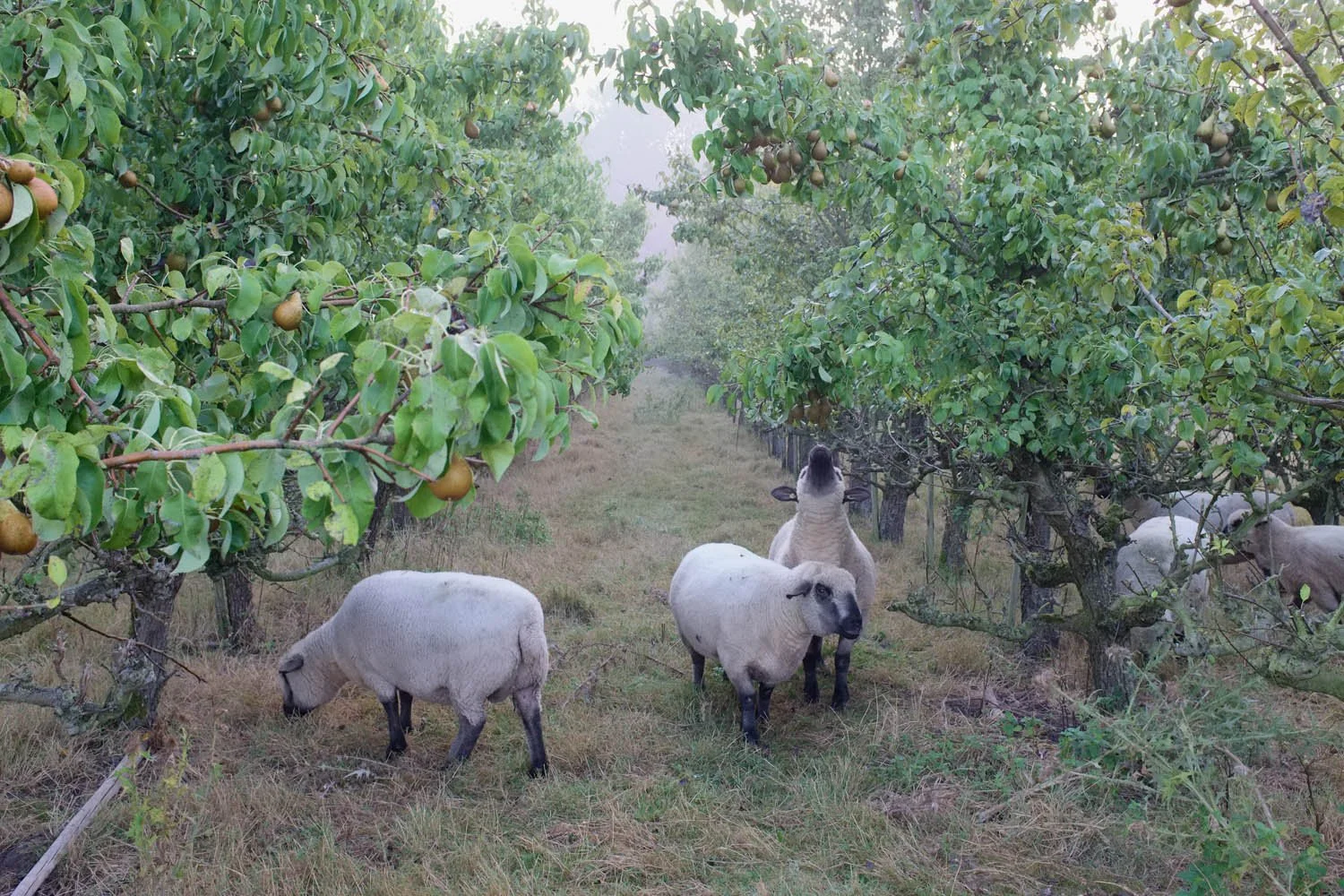
Hampshire Down sheep graze in the uncleared section of the old pear orchard of the Proeftuin van Linschoten. They keep the grass short and mostly free of weeds, with the exception of nettles. Their droppings fertilize the soil. The pears will be harvested in the fall and juiced.
Linschoten, The Netherlands. August 2022.
It was a lovely Indian summer, they all sigh wistfully, but this now really is a chilly and damp autumn day. They are wearing rain suits, windproof jackets and warm headgear, the two gardeners and five volunteers that have come to Dutch market garden Proeftuin van Linschoten, to make it winter ready. “As long as you keep moving, it’s doable,” volunteer Jannie remarks, displaying a tough ‘no hat wearer’ attitude. But a little later even she asks if there’s still one left.
Small market gardens that sell healthy, fresh vegetables to local people by subscription and involve them with their cultivation are springing up all over the Netherlands. The initiators often do not even have a farming background. Many say they don't want to wait any longer for politicians to finally come up with better agriculture, nature and climate policies.
The 'Taste Garden of Linschoten' is one of those new produce gardens. Starting in 2022, initiator Natascha Boel and gardeners Gennaro Scognamiglio (in 2022), Matty Vink, Emma Smeets en Jantien Meijer, with the help of over twenty loyal volunteers, have been changing half of and old pear orchard into a nature friendly, biodiverse community garden. They grow a large variety of seasonal greens, fruits, herbs and (edible) flowers, without using fertilizer or pesticides.
-
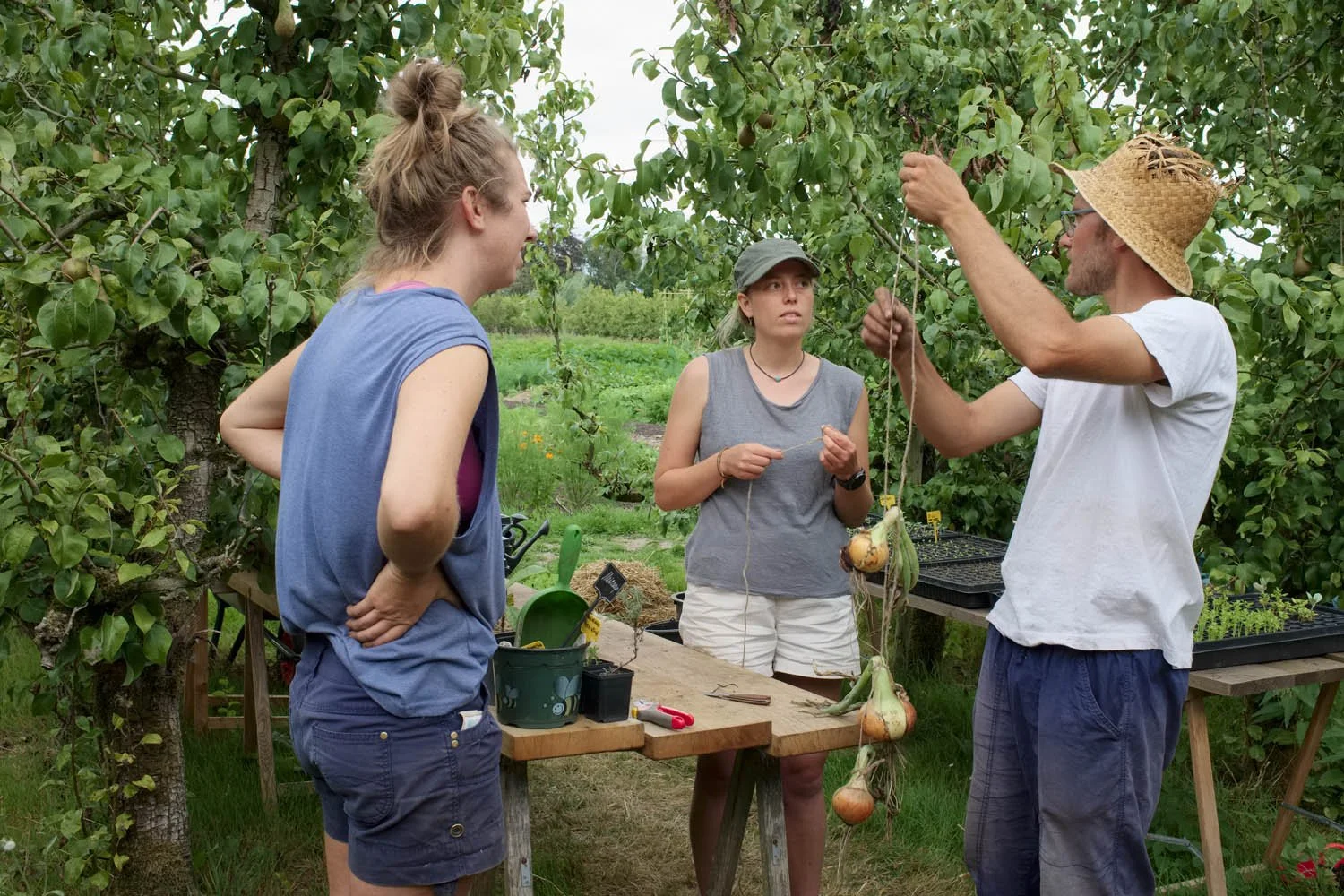
Gennaro Scognamiglio, ecological gardener and botanical artist, came up with the design of the garden landscape for the Proeftuin van Linschoten, which is still used as its basis. He left as its master gardener in the fall of 2022. Here he shows volunteer Nina (left) and part-time help Matty Vink, who would later succeed him as a gardener, how to string freshly harvested onions with rope to hang them up for drying. August 2022
-
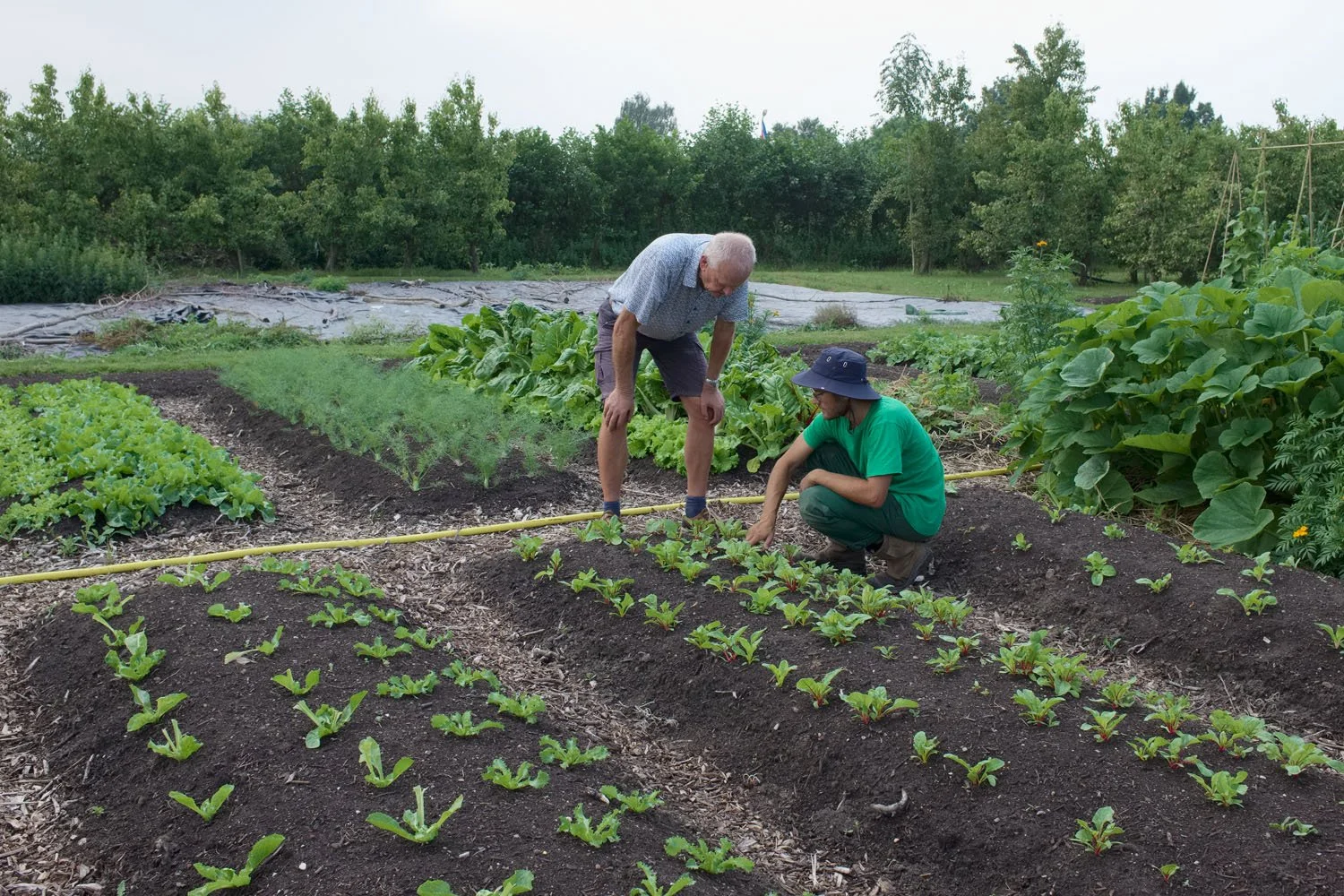
Gennaro shows volunteer Maarten how to thin out beet plants. August 2022
-
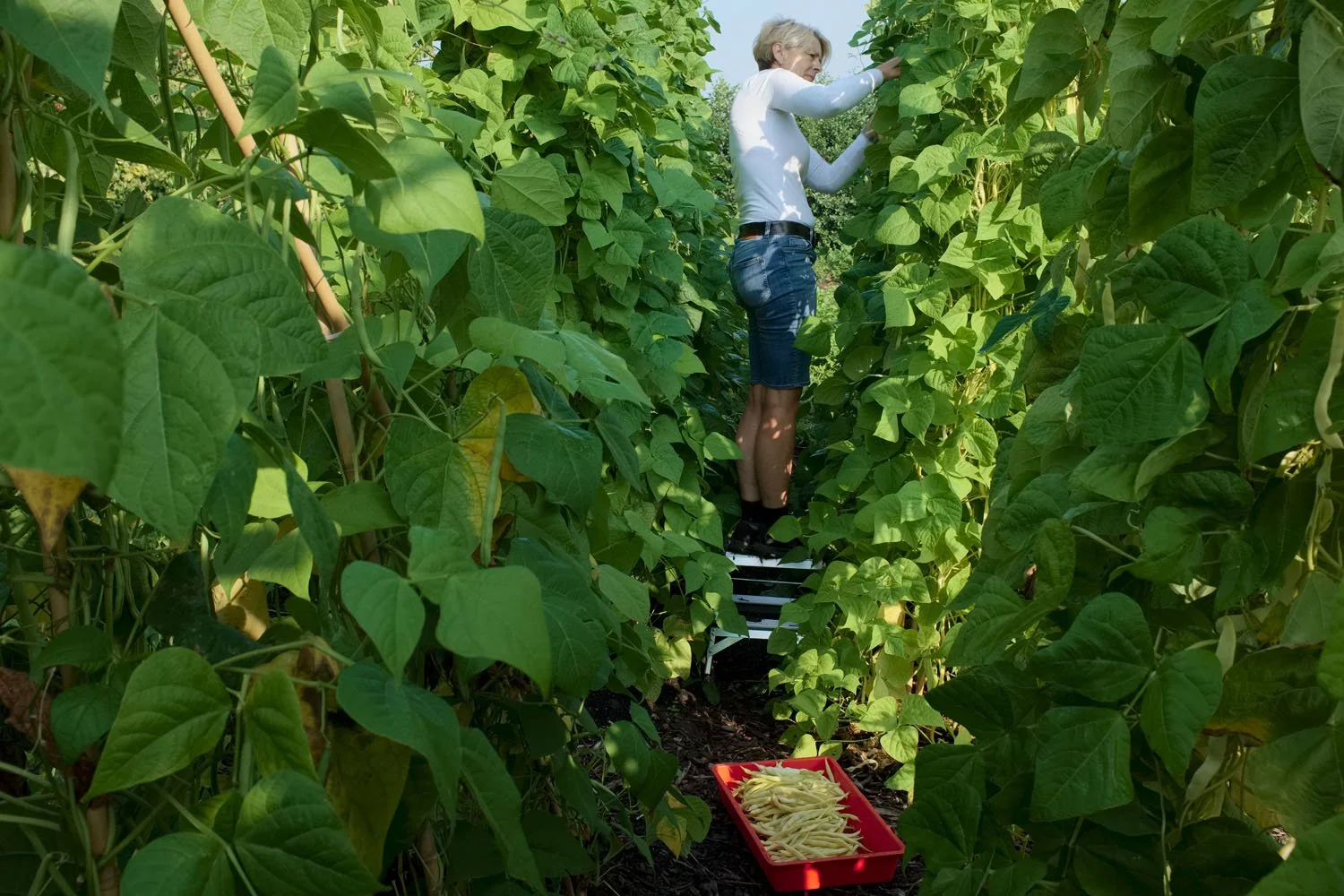
Andrea, who has just started as a volunteer at the Proeftuin, picks yellow string beans. At this Dutch ecological market garden only seasonal vegetables and fruits are grown. August 2022
Never sown even a head of lettuce
Because she didn’t want to stay on the sidelines while every morning reading more alarming news about climate change, Natascha Boel, a lawyer/artist/illustrator/yoga teacher, who herself “never even had sown a head of lettuce,” decided to become more self-sufficient. During the covid years 2020 and 2021 she learned the basic principles of organic and sustainable gardening as an intern at a market garden and sought inspiration at many others. What was intended to be a kitchen garden for four persons in her own back yard in the village of Linschoten, grew into an ‘edible landscape’ and meeting place when she got the opportunity to lease the adjacent pear orchard of Landgoed Linschoten, a private estate consisting of a mansion, surrounded by woods and pastures.
The Proeftuin is accredited as an innovative European LEADER project, which earned it financial support for the construction of vegetable beds, a shed and two greenhouses from the European Fund for Rural Development and the Dutch province of Utrecht.
The original garden landscape has been designed by ecological gardener and botanical artist Gennaro Scognamiglio. He is an Italian globetrotter who lives in the nearby town of Woerden and had a part-time job as a postman there (which will turn out to be important later in this story). 2022 was a pilot year, to see if the soil, a very dense river clay, would be suitable for growing vegetables. It was a big success: the garden 'exploded' or, as Natascha described it: “the veggies popped like popcorn out of their growing beds,” and its abundant flowers attracted many pollinating insects.
Winter and spring of 2023 brought a flurry of building activity of a different sort. For months the garden looked more like a muddy battlefield than a sunny paradise: irrigation and power lines were installed in trenches, pear trees were uprooted and replanted to make way for two greenhouses and two tiny eco-lodges, which will provide rental revenue contributing to the rent of the land. But nesting-boxes mounted in the hedgerow already invited 26 different bird species.
In May of that year, new gardeners Matty Vink and Emma Smeets, both recently graduated from a biodynamic agricultural college, were able to sow and plant, thanks to the sale of the first CSA (Community Supported Agriculture) shares. Since customers pay for their produce up front for the entire growing season, the garden can invest in seed, seedlings, compost and tools without having to borrow money.
Shareholders are encouraged to self-harvest. They receive a weekly email with online links to Youtube clips in which the gardeners explain how to cut spinach so it will grow back for a second cutting, or how to detach a head of lettuce from its roots by carefully turning it around. In four years they hope Proeftuin van Linschoten will be a viable business, so that it can continue reconnecting people, nature and agriculture.
-

By the end of autumn, some already bare planting beds are covered with mulch and leftover plant parts, to protect the soil against drying out, frost and erosion. In other beds (right) green manure cover crops like winter rye and mustard, which enrich the soil with nitrogen and improve its structure, have been sown. November 2022
-
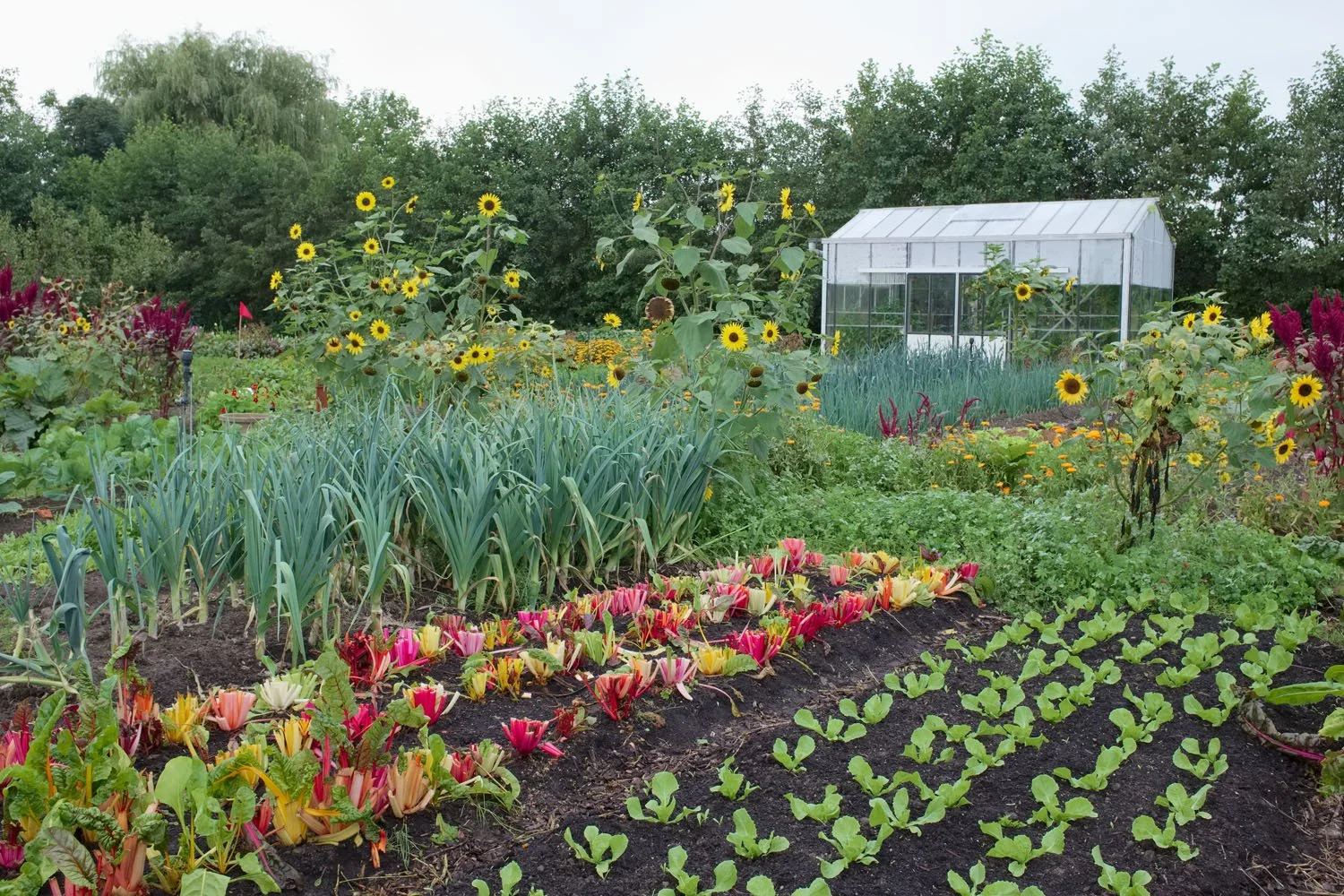
Red chard can grow back if it is harvested the right way. September 2023
-
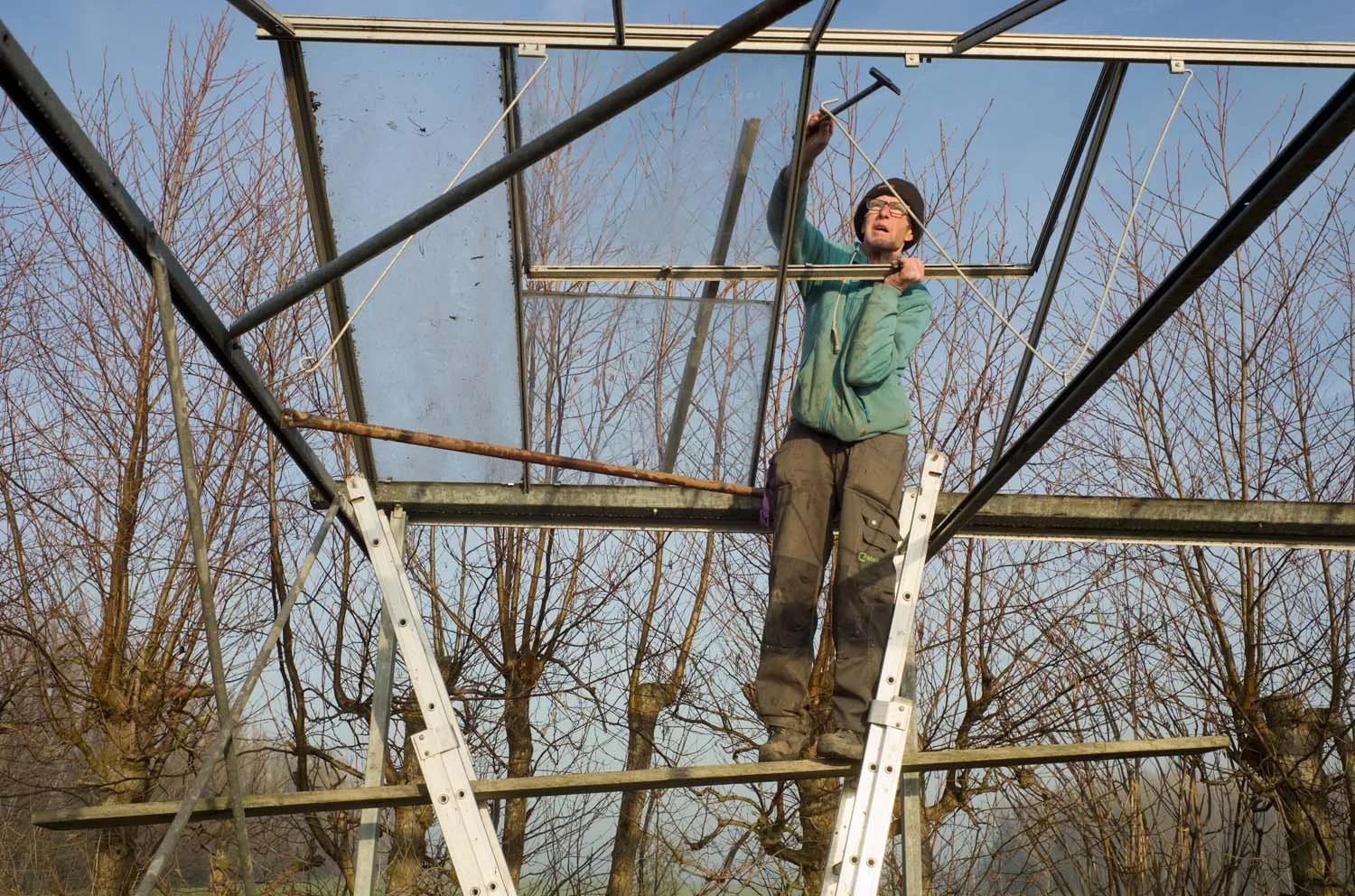
Mister Hendriks (85) builds a greenhouse. February 2023
-
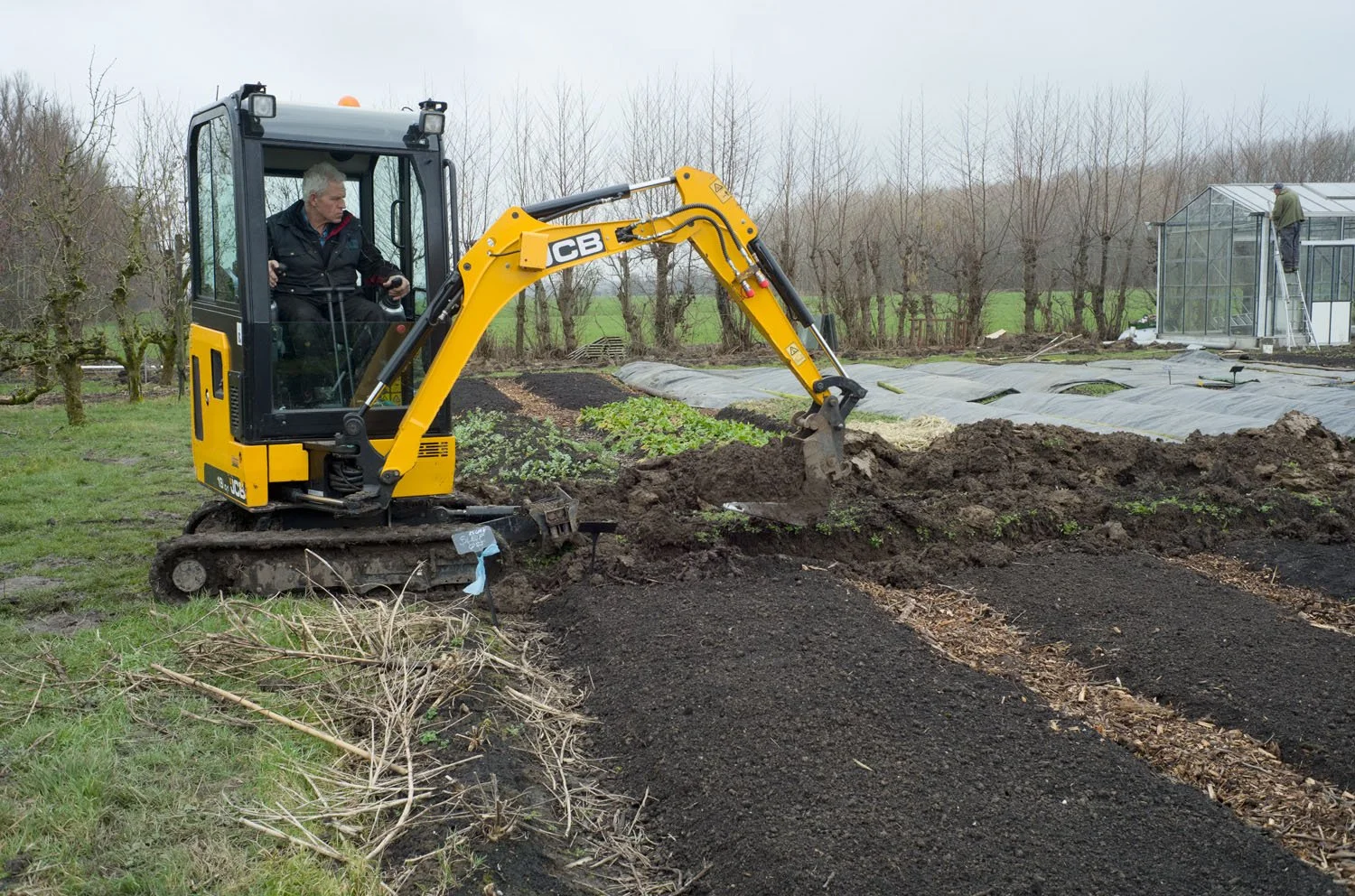
With a lightweight excavator, which impacts the soil as little as possible, trenches are dug for irrigation pipes and power lines. On the right a greenhouse is being built. February 2023
-
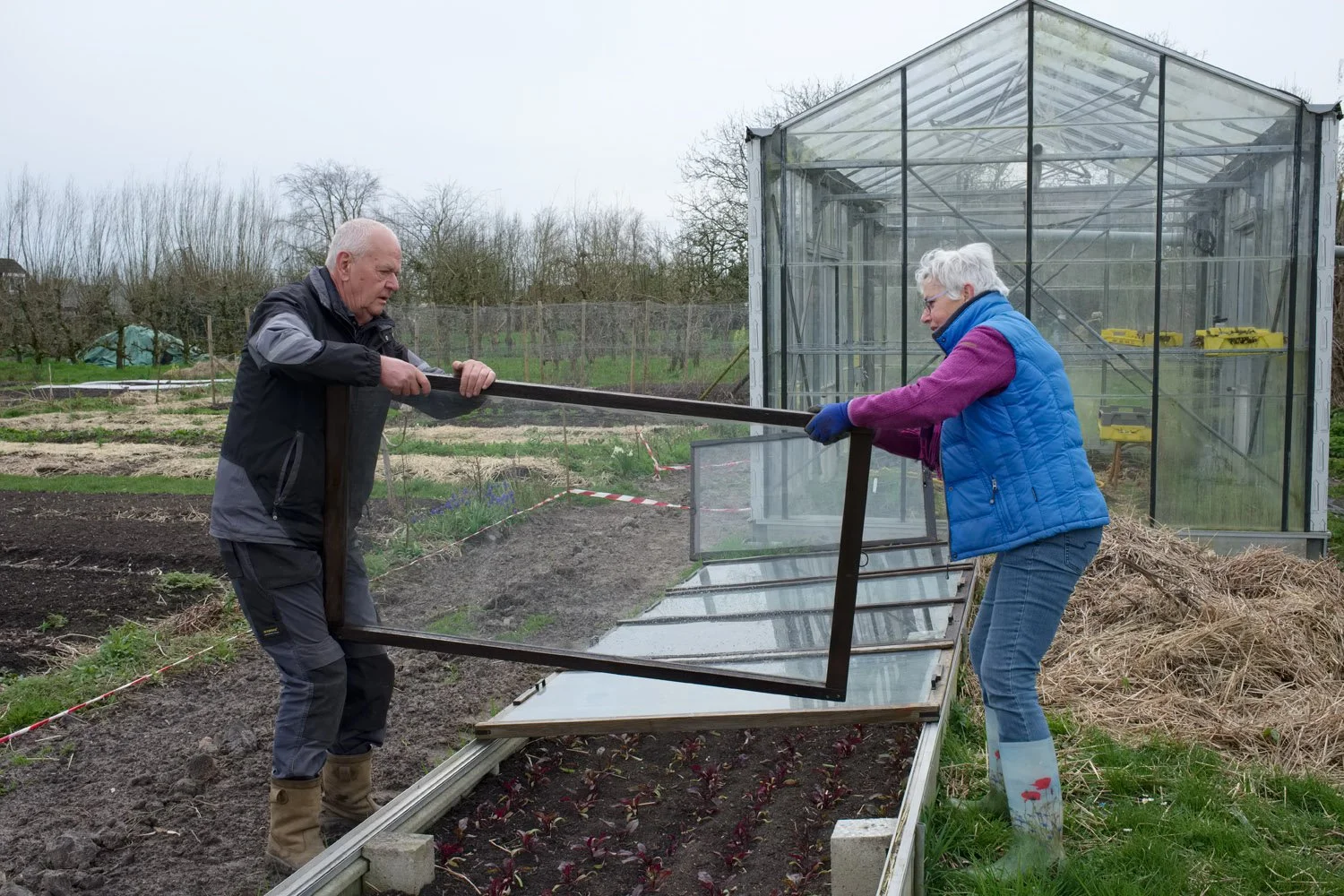
Volunteers Maarten and Jannie replace glass windows on two low greenhouses, after they have been painted and fitted with handles. March 2024
-
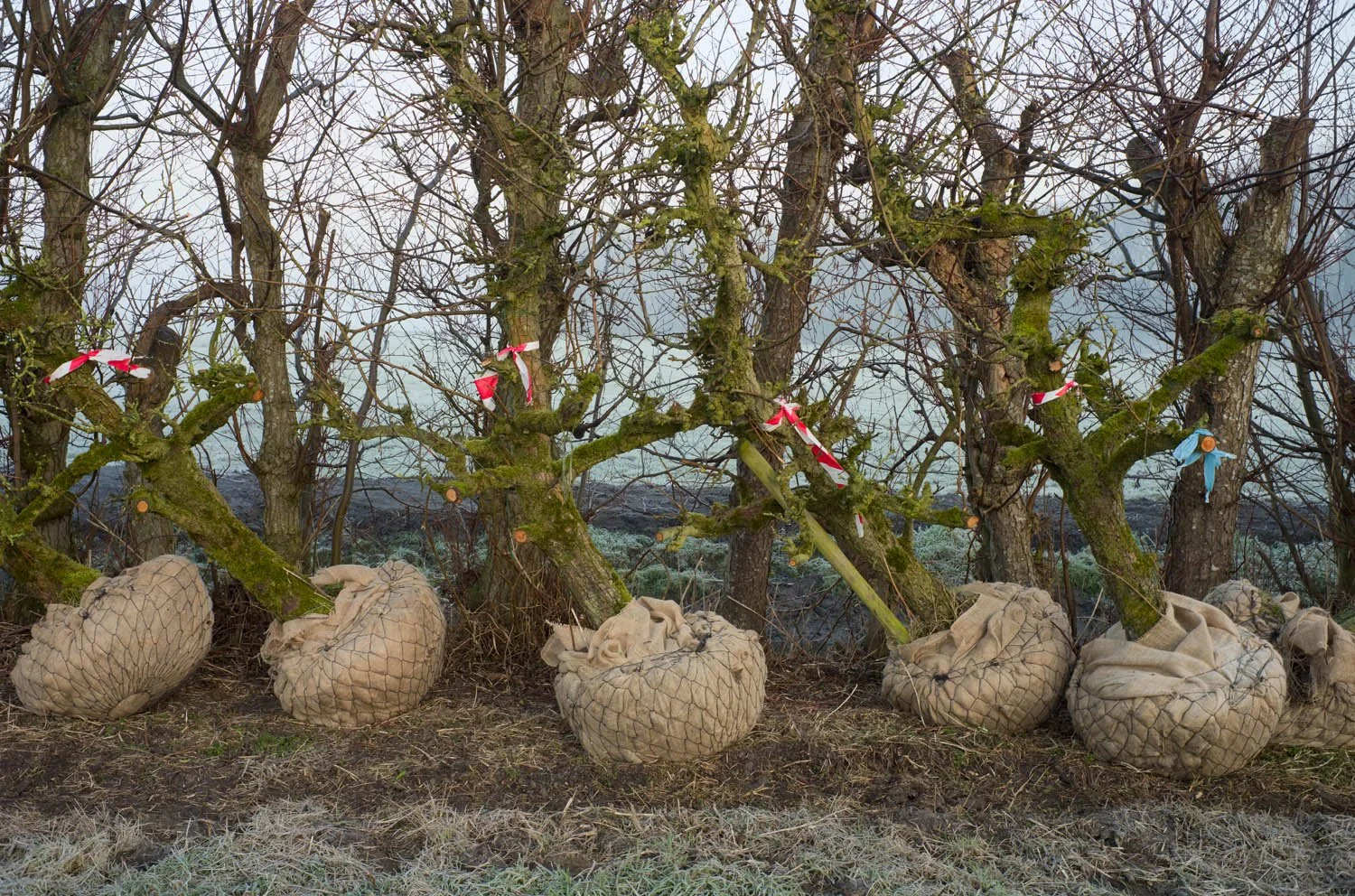
Over a hundred old pear trees have been dug out – root ball and all – to make way for a large greenhouse, two eco-lodges and fruit bushes. They will be replanted elsewhere. February 2023
-
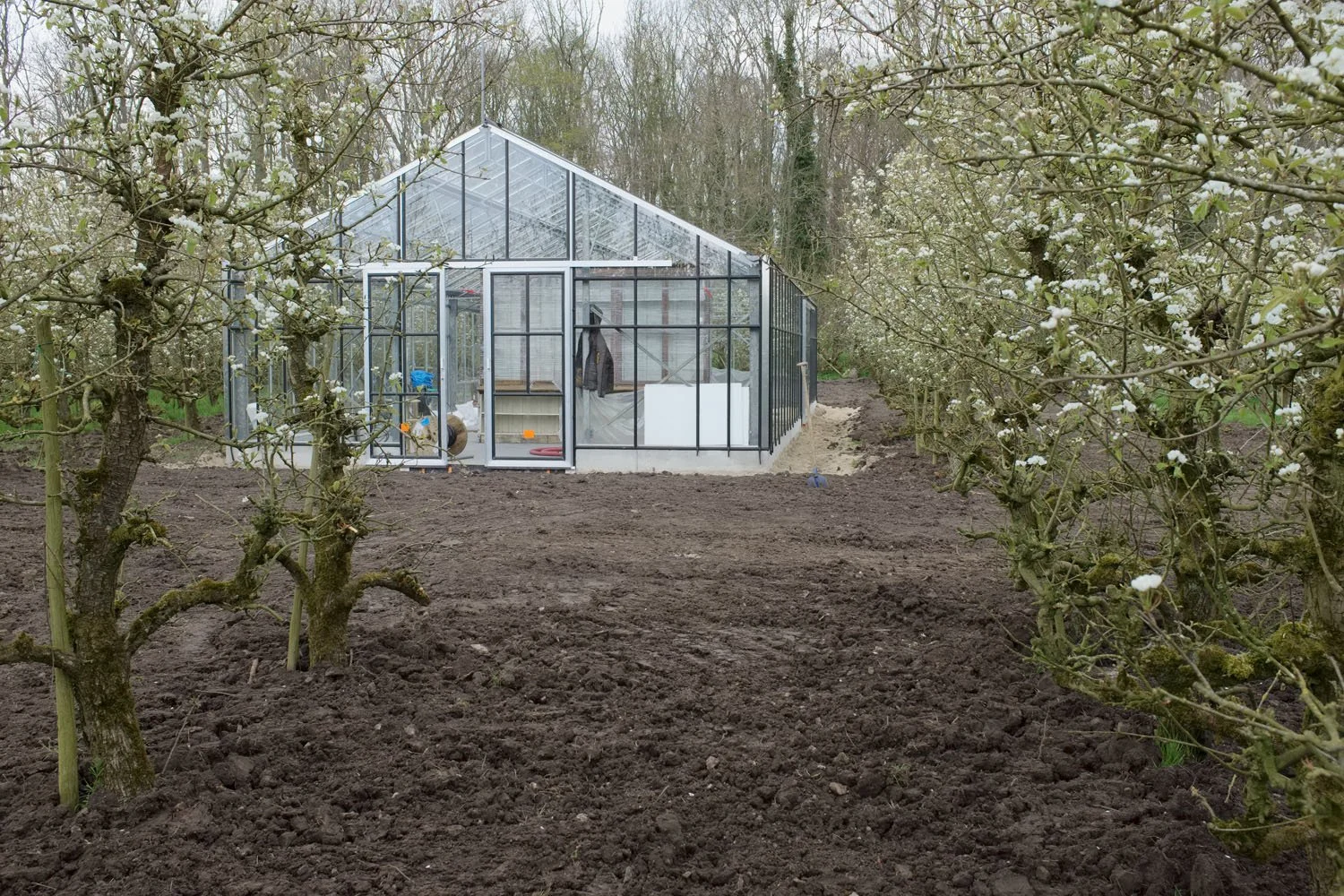
The large greenhouse among blooming pear trees. April 2023
-
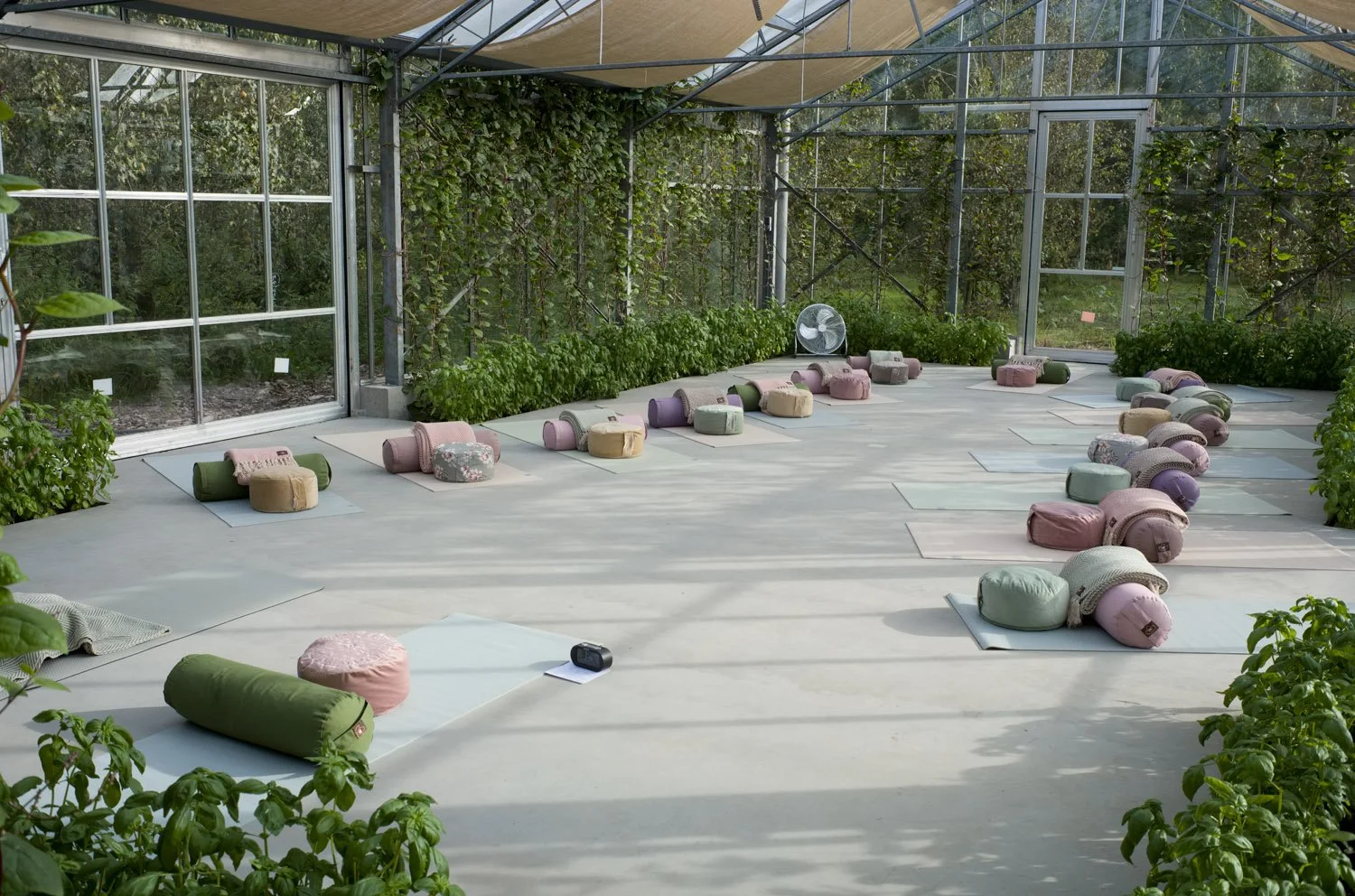
The greenhouse has been readied for a yoga lesson between malabar spinach and fragrant basil. September 2023
-
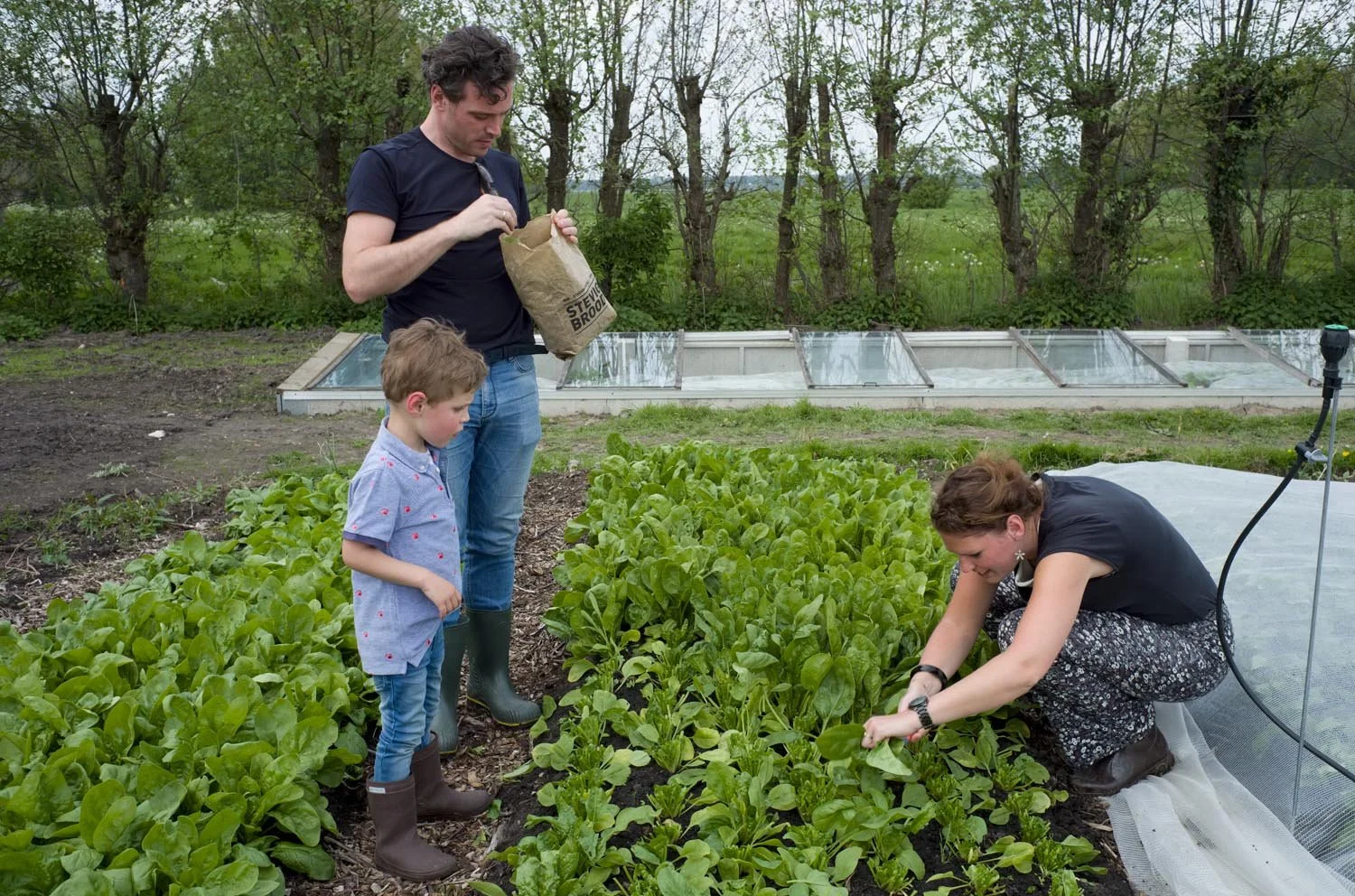
A family self-harvests spinach for the first time. The leaves are collected in a recycled bag given to them by the gardeners that says in Dutch: “City Bakery, Firm Bread”. May 2023
There is a lot of work in one cucumber
In the 2023 and 2024 growing seasons, a vegetable subscription, which runs for thirty weeks, is sufficient for 1 to 2 people and contains an average of 6 -10 different types of vegetables depending on the season, costs € 10 per week. In late autumn 2024, the garden women sent an extra newsletter to their vegetable subscribers with a detailed calculation of costs and benefits and a survey: "In order for the Proeftuin to be a sustainable success, where the gardeners earn a fair wage and the annual costs are covered, the prices of the vegetable packages have to be increased.”
“The customer is looking at: what do I pay for a cucumber at the supermarket,” says Natascha, “but in one cucumber there is a lot of work: pre-sowing, planting, caring, harvesting. Ultimately I want to express that in the price.”
In more than one way, the subscribers' contribution is a 'solidarity payment', the website of the garden explains.“In agriculture this stands for fair wages for the farmer. In addition, people who have less to spend are also enabled to participate. This is in line with our desire to keep healthy local food available to everyone.” In other words: people who have the means are encouraged to pay more, those who have less can ask for a rebate.
Natascha regularly checks what organic vegetables cost at the supermarket, and has so far been happy to see that the package the Proeftuin offers is cheaper, even after the price increase.
-
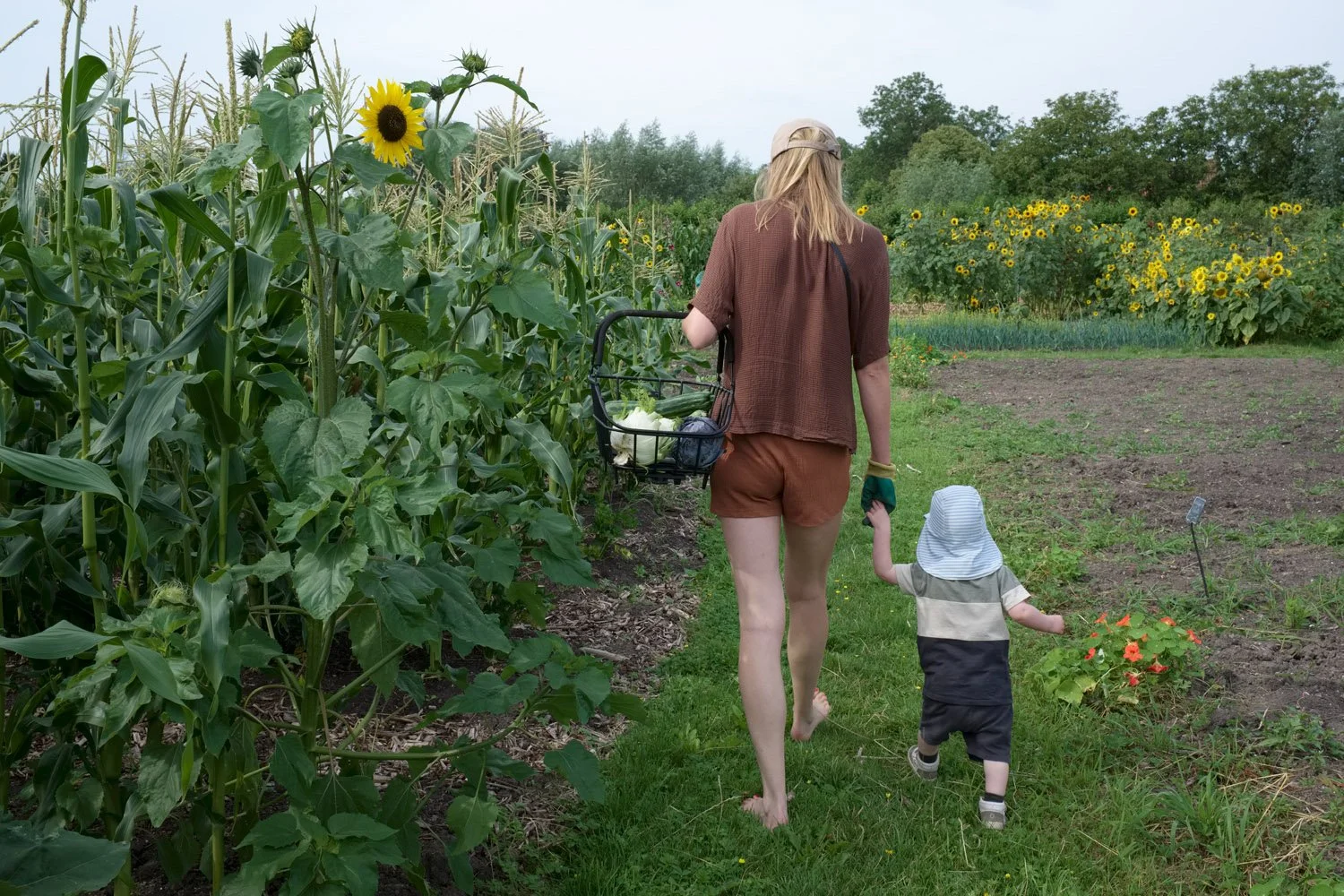
Vegetable subscriber Cindy and her son Luca collect their weekly share. July 2024
-
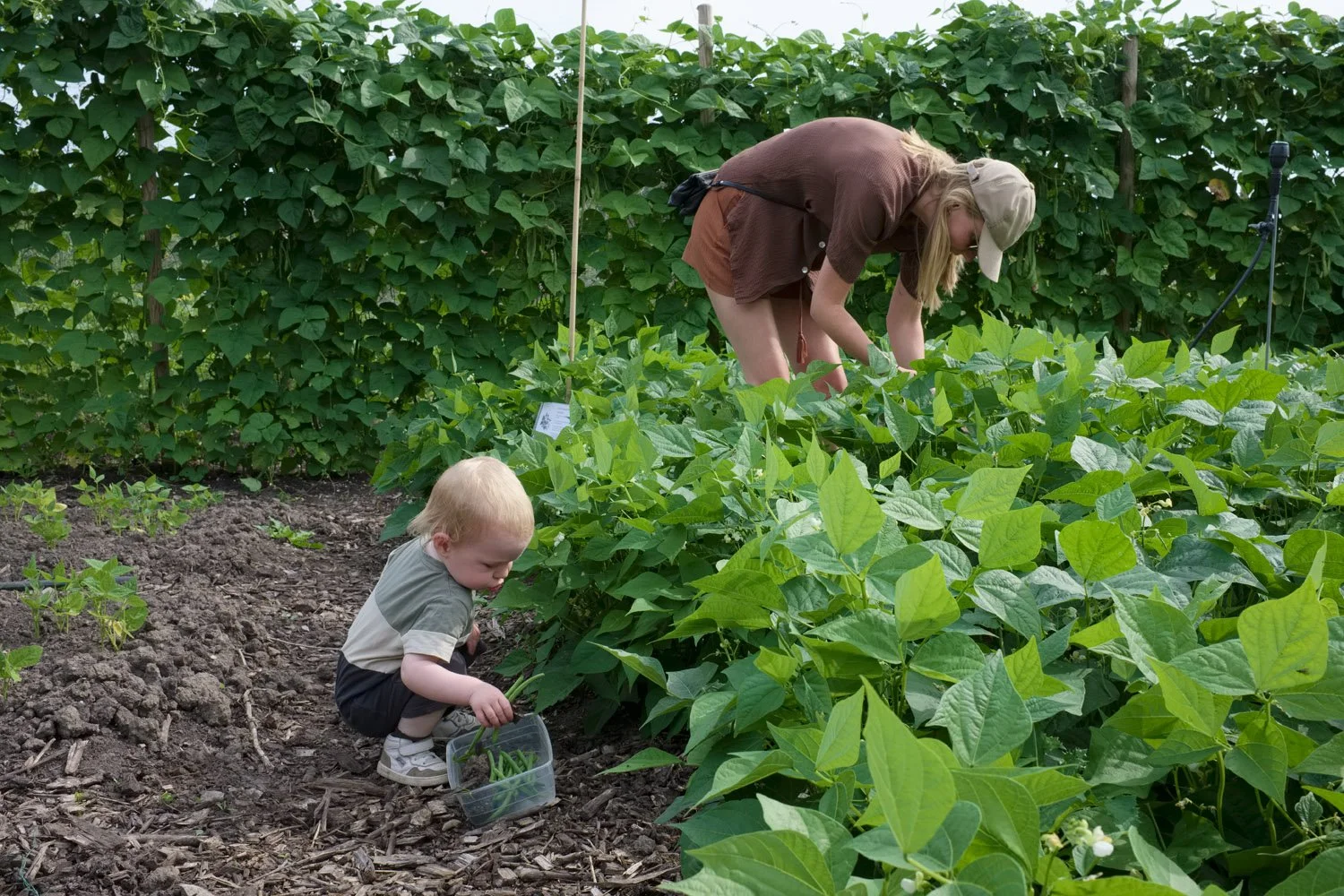
Cindy and Luca harvest two vegetable packages weekly. Luca may put the green beans that his mother has picked into a container brought from home. July 2024
-
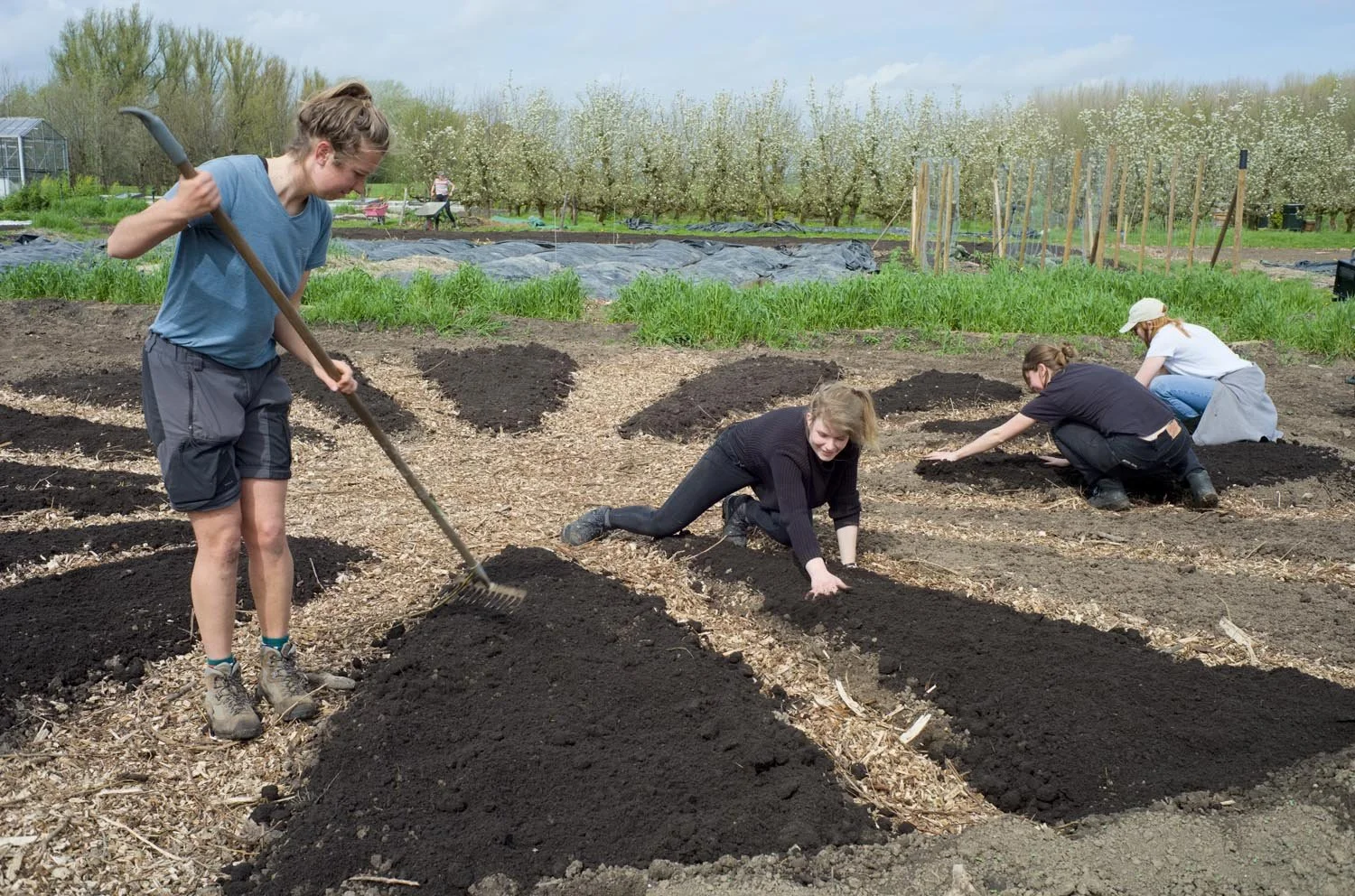
Volunteers cover the new herbal circle with fresh compost during the first Lend a Hand Day at the Proeftuin. Blossom adorns the pear trees in the remaining part of the old orchard. April 2023
Pleasantly sweating
The permanent gardeners can now count on the enthusiastic help of about twenty volunteers from surrounding villages and cities such as Linschoten, Woerden, Montfoort and Oudewater. They come to weed, sow, plant and harvest at least one morning or afternoon a week during the growing season, which runs from February to the first week of December. In its first three years the garden has already grown into a close-knit community of people who like to work outside in nature and want to grow and eat healthy vegetables.
Maarten Snoek was the first volunteer in the garden. "I love working here, with my hands in the ground, then you are pleasantly sweating.”
He grew up on a dairy farm, but when he left secondary agricultural school, his parents decided that his brother, eight years younger, should eventually take over the farm. “My father was too young to quit. My mother said: ’Two captains on a ship, that doesn’t work’.”
From 1975 to 2001 he was a compound feed specialist and agricultural advisor. After that, with a partner, he had an agricultural real estate agency in Woerden until 2022. At some point he started a kitchen garden. “Because I wanted something like that, something completely different than the job. On one of the last days at my office, postman Gennaro threw a leaflet in the letterbox, about the Proeftuin looking for volunteers. Then I got an audience here in the kitchen with Natascha and ... Gennaro.”
That’s when, according to Natascha, he spoke the legendary words: “I want clear tasks.”
Maarten confirms it: “I like clear agreements and goals.” Since then he has been a key figure for the Tuesday volunteer group. He shows a photo from right after the pear trees were cleared. “This was what I saw when I came.” Proudly: “And this was the first path I built.”
Natascha: “There was nothing at all! So actually under the leadership of Gennaro you have, step by step ... "
Maarten: “He taught me a lot. He also explained why he did everything. You learn from that.
"There are many nice people who volunteer here. I try to talk to everyone, occasionally provide a listening ear. Society is hard, it rages around you and you can't keep up with it. Here you have a form of peace and genuine interest and appreciation.
"I love Tuesdays. In my system, Tuesday is Proeftuin. When it rains hard you can think: I'll beg off, I am a volunteer, nothing is mandatory and everything is allowed. But you know that there are people who count on you, who will be sorry if you're not there. That's enough reason to say: I'll go!”
-
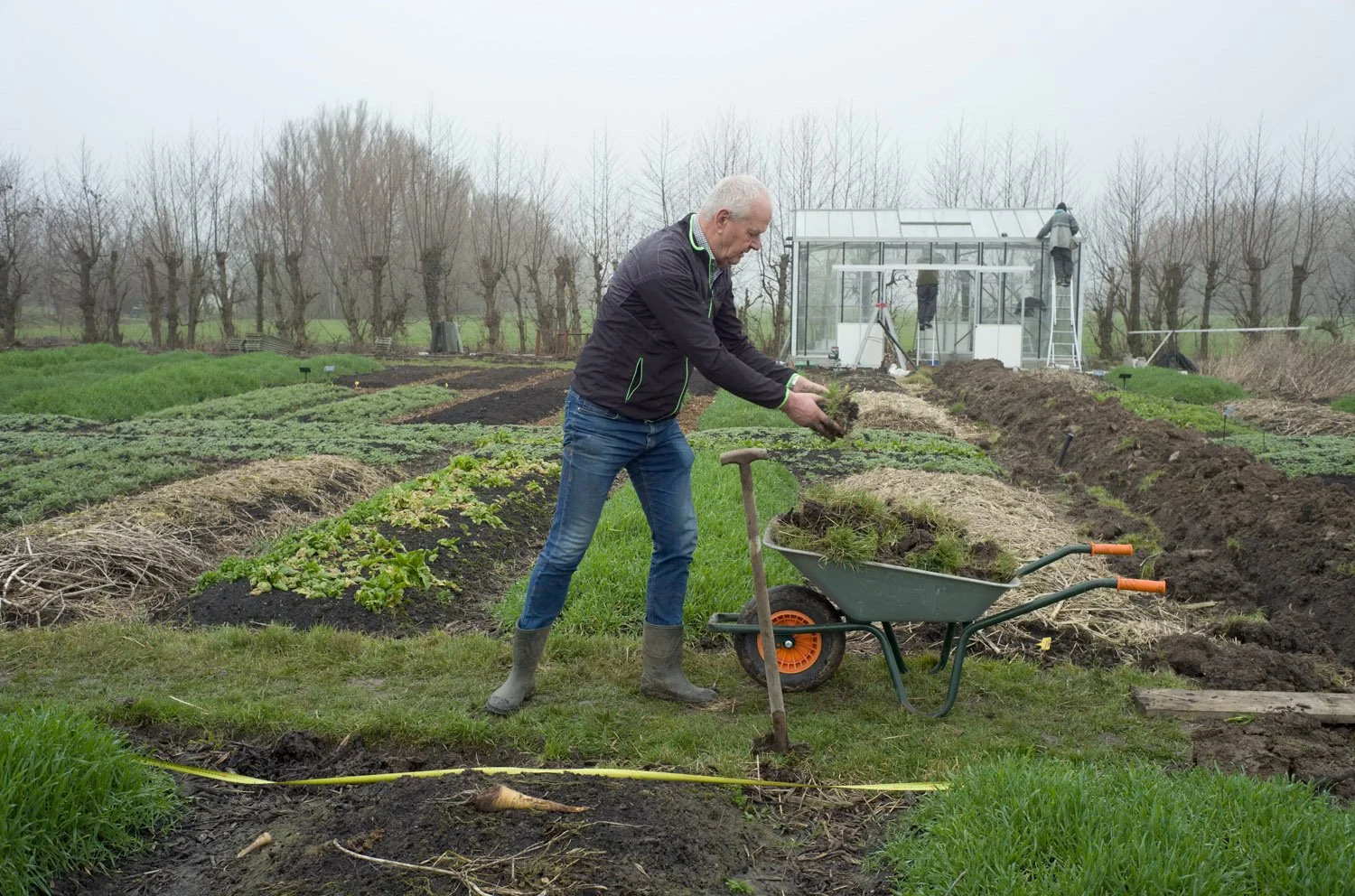
Volunteer Maarten straightens grass edges along cultivation beds. In the background, the small glass greenhouse is being finalized. February 2023
-
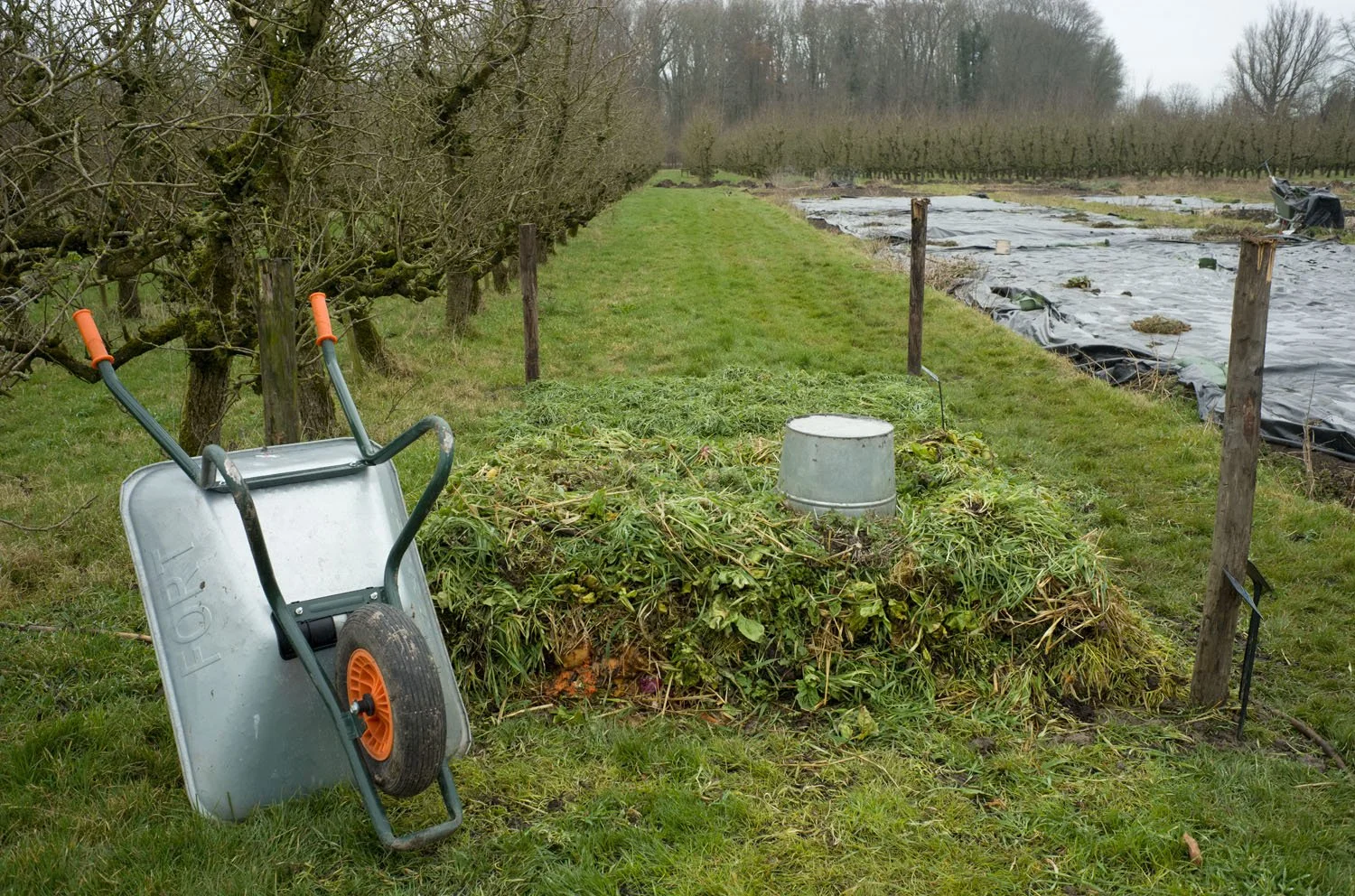
All the removed weeds, vegetable residues, clipped grass and other plant waste end up in various compost heaps in the garden. There is still a lot of organic compost to be bought, but in the end the gardeners hope to close the cycle and be self-sufficient. February 2023
-
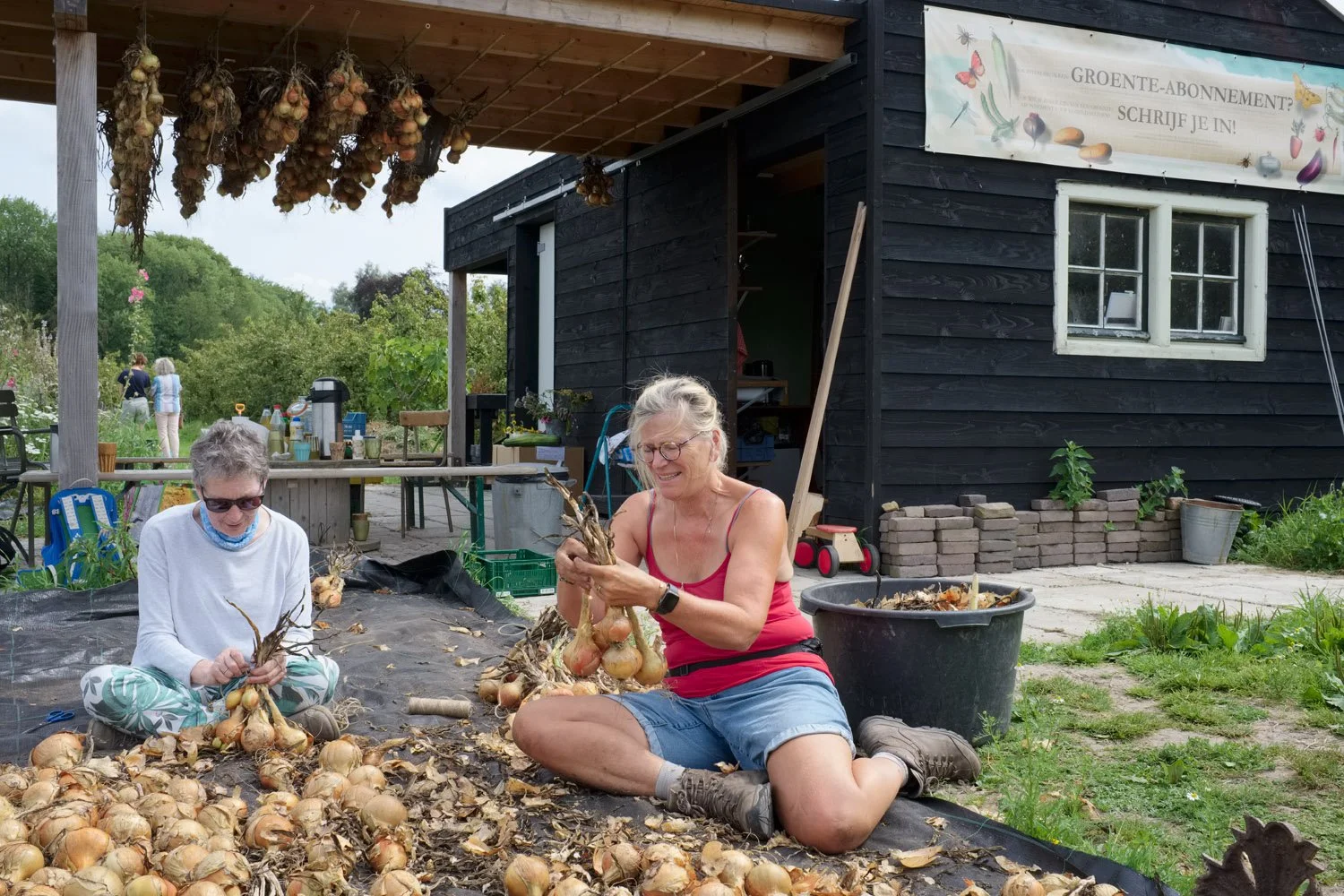
On the monthly Lend a Hand Day, volunteers Caroline (left) and Andrea braid onions that have been drying on a tarp on the ground since the July harvest. The braided bunches are hung under the porch roof in front of the work shed to dry further. August 2024
-
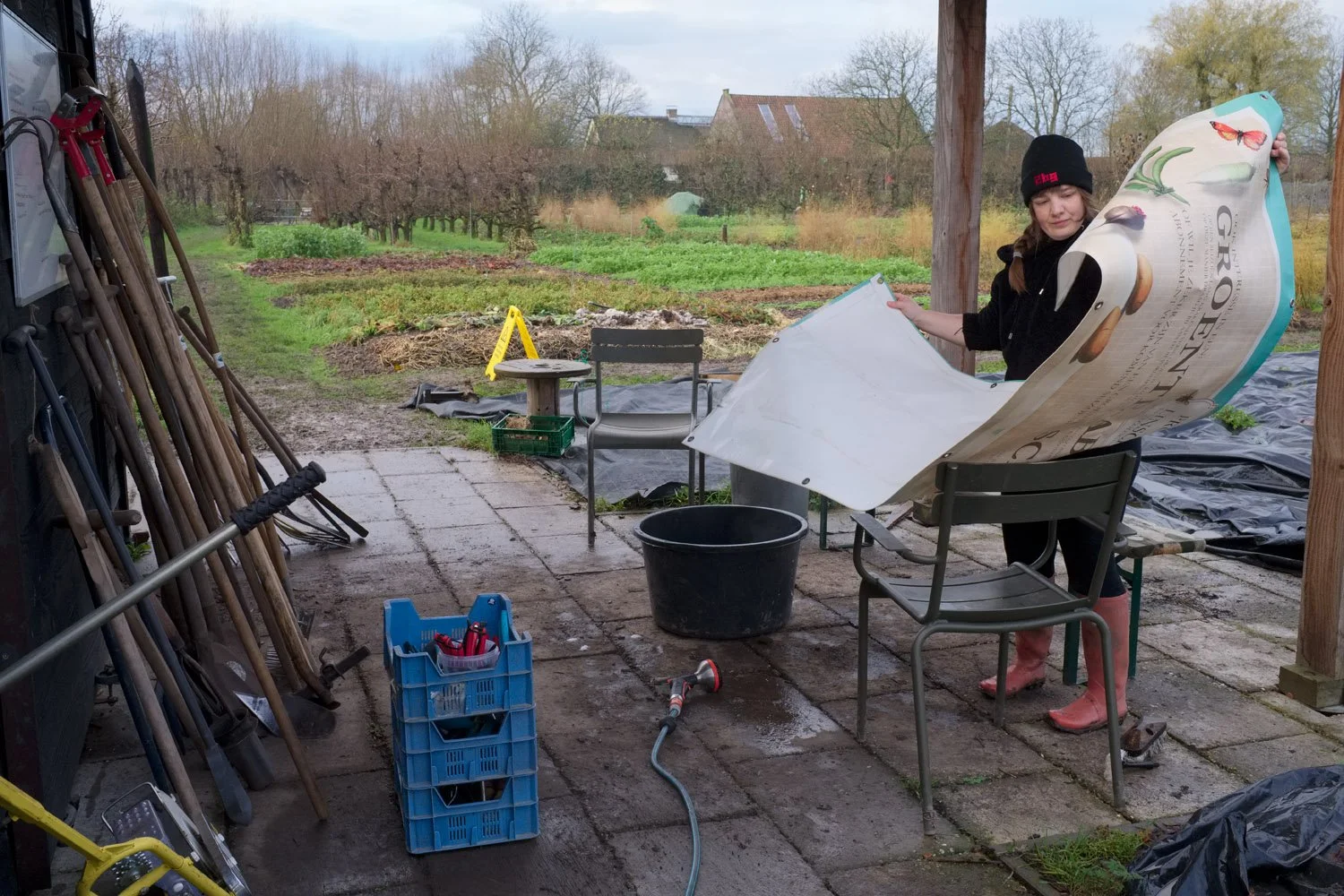
During the winter preparation of the Proeftuin, intern Bell cleans one of the banners inviting visitors to take a vegetable subscription. All garden tools are against the shed and in crates, they will be cleaned, oiled and sharpened if necessary. December 2024
-
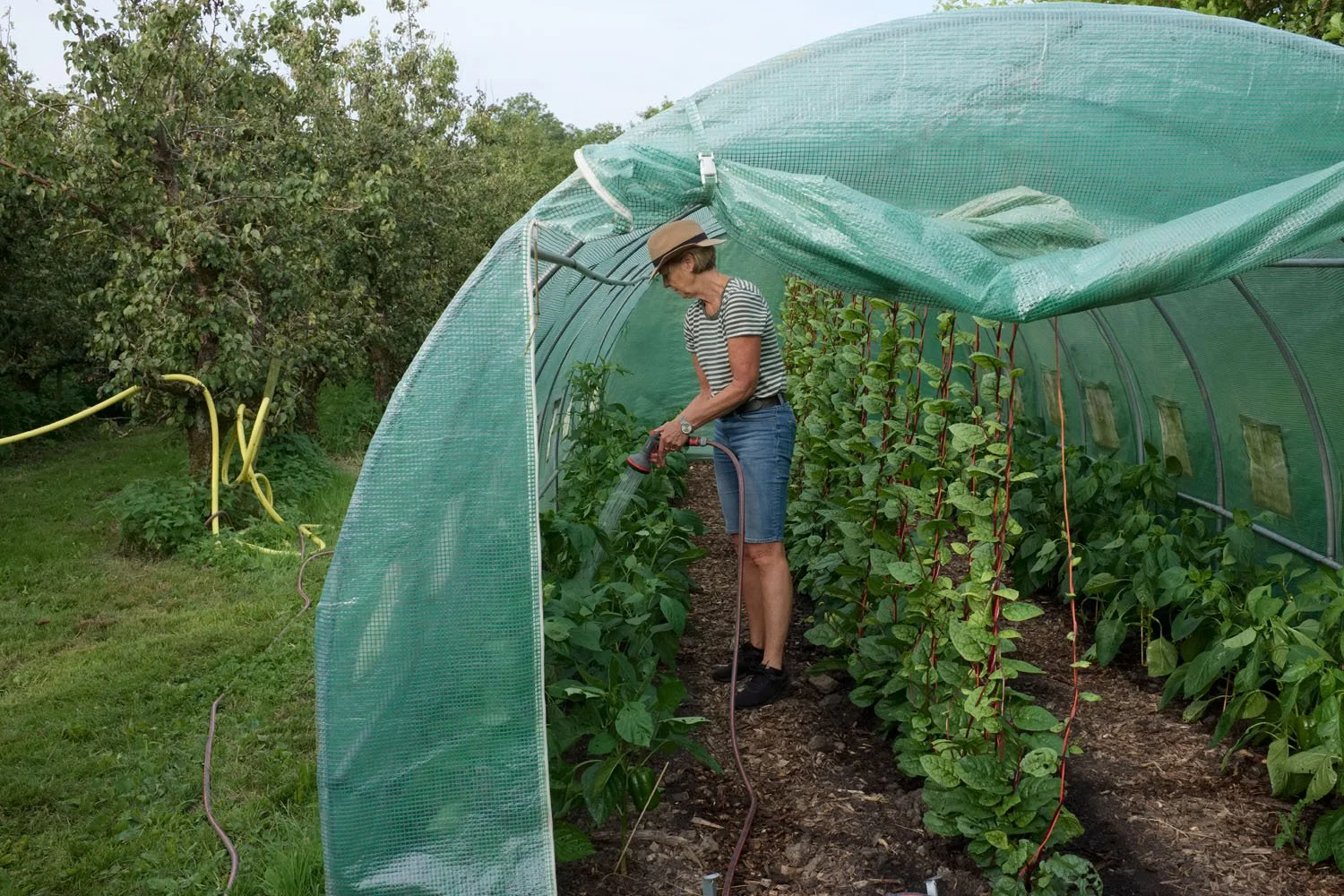
Volunteer Andrea waters peppers and malabar spinach in one of the two tunnel greenhouses. July 2024
Manual work stimulates soil life
In the last week of March 2023 there is a strong wind on the vegetable garden. White clouds sail past in the blue sky. The sun caresses the dark earth of the vegetable beds. Ducks fly over in pairs, quacking, in search of good nesting facilities. The yellow-green colored, down-curved branches of a weeping willow flutter, other trees are also breaking buds. The first days of a new Dutch spring.
Almost all work in this garden is physically demanding hand work. After half of the forty-year-old pear trees had been cleared, the released land was tilled once; since then, even during the construction of the irrigation system and the electricity cables, no heavy machinery has been used. The aim is to promote soil fertility, soil life and biodiversity with crop rotation and a lot of biocompost, but minimal tillage.
The plants grow in raised beds, laid out with the clay from the surrounding paths. The compost is replenished after each crop change. This makes the soil more airy; soil life develops, and with their root structures and sometimes nitrogen-binding properties, the crops in turn also feed the soil. Around it, ditches provide water drainage, so that the roots are never submerged for too long. The ditches also function as paths and are covered with wood chips, which also compost and promote the growth of mushrooms and other fungi.
The river clay, deposited for centuries by the nearby small river Lange Linschoten, turned out to be mixed with some sand. Sand is good for drainage. But clay and sand stick together, which leads to subsidence. So it is forbidden to step on the cultivation beds in the Proeftuin. You walk on the paths.
-
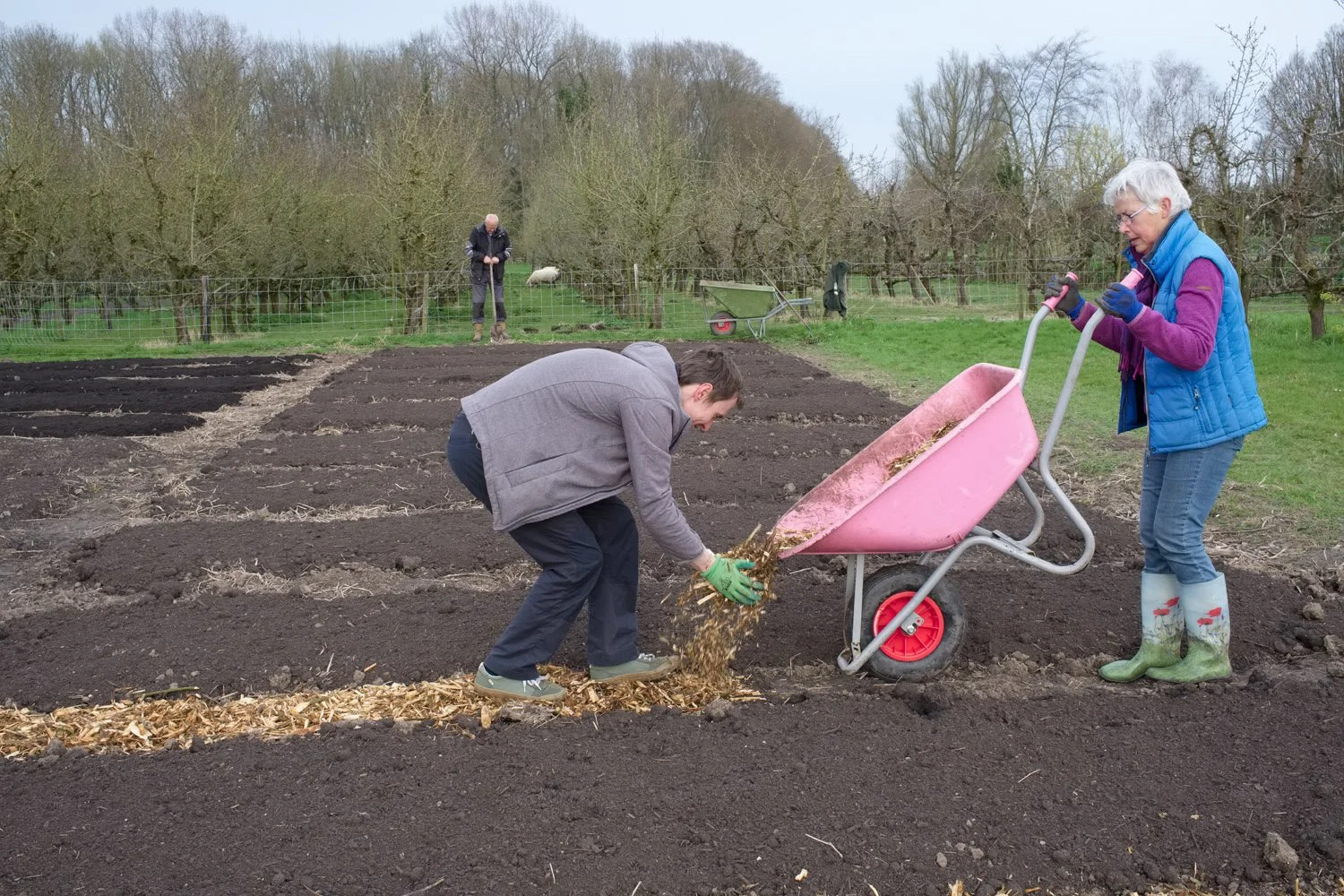
Volunteers Wouter and Jannie make paths with wood chips between new potato beds covered with a fresh layer of compost. In the background, Maarten straightens the grass edges of the new beds. March 2024
Clay retains water, but also many nutrients that are not directly absorbable by plants. For this they need the help of soil life, and in the old orchard that was hardly present anymore. The gardeners therefore do everything they can to stimulate this in the cultivation beds, by feeding the soil with organic substances, but also leaving it alone as much as possible. No plowing or turning, at most the compact clay is loosened up with the spading fork.
The three main nutrients absolutely necessary for plants are nitrogen, phosphorus and potassium. Nitrogen is responsible for above-ground vegetative growth of plants and for size and vigor. Phosphorus promotes healthy growth, strong roots, seed formation and the ripening of fruits and tuber formation in tuberous plants such as celeriacs. Potassium is essential for the development of strong plants and helps them resist diseases and fungi. It also limits evaporation, reducing susceptibility to frost and drought.
You can also find these nutrients in fertilizer, but if you give them in that way, in mineral form, immediately absorbable for the plant, it absorbs as much as it can, and everything it cannot take in, washes out into a ditch or blows away in the air. And due to the high concentration of mineral salts in it, it kills many of the soil organisms responsible for degradation and soil formation.
Organic compost is therefore used in the garden to feed the soil. Crop rotation ensures that diseases in the soil have less impact on the plants and combination cultivation with flowers and herbs attracts (often useful) insects. This ensures a healthy ecosystem.
-
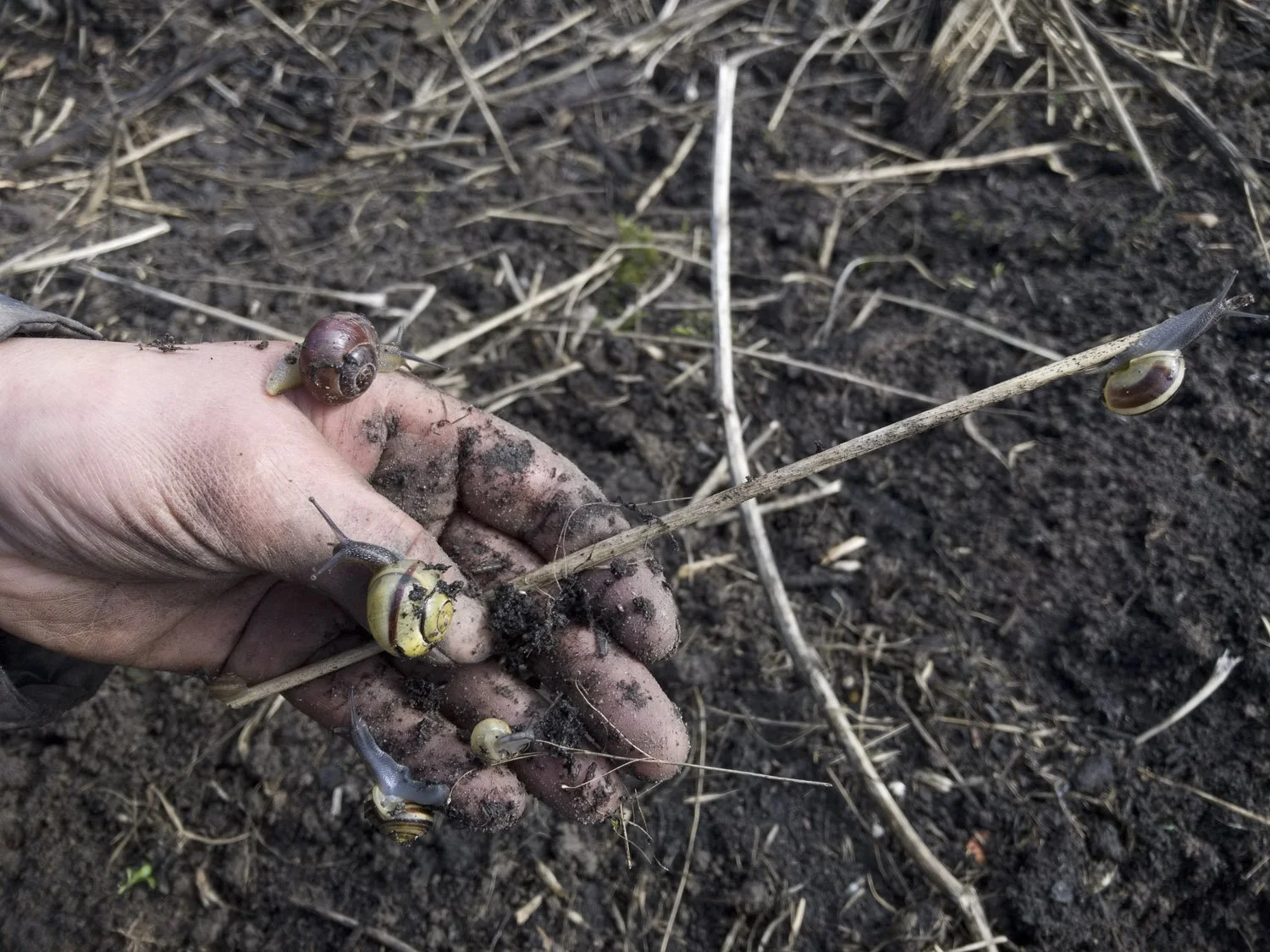
Gardener Emma finds snails in one of the vegetable beds. They eat from the plants, but are also excellent humus makers who eat dead and rotting organic and animal material and are themselves food for birds and hedgehogs. March 2023
-
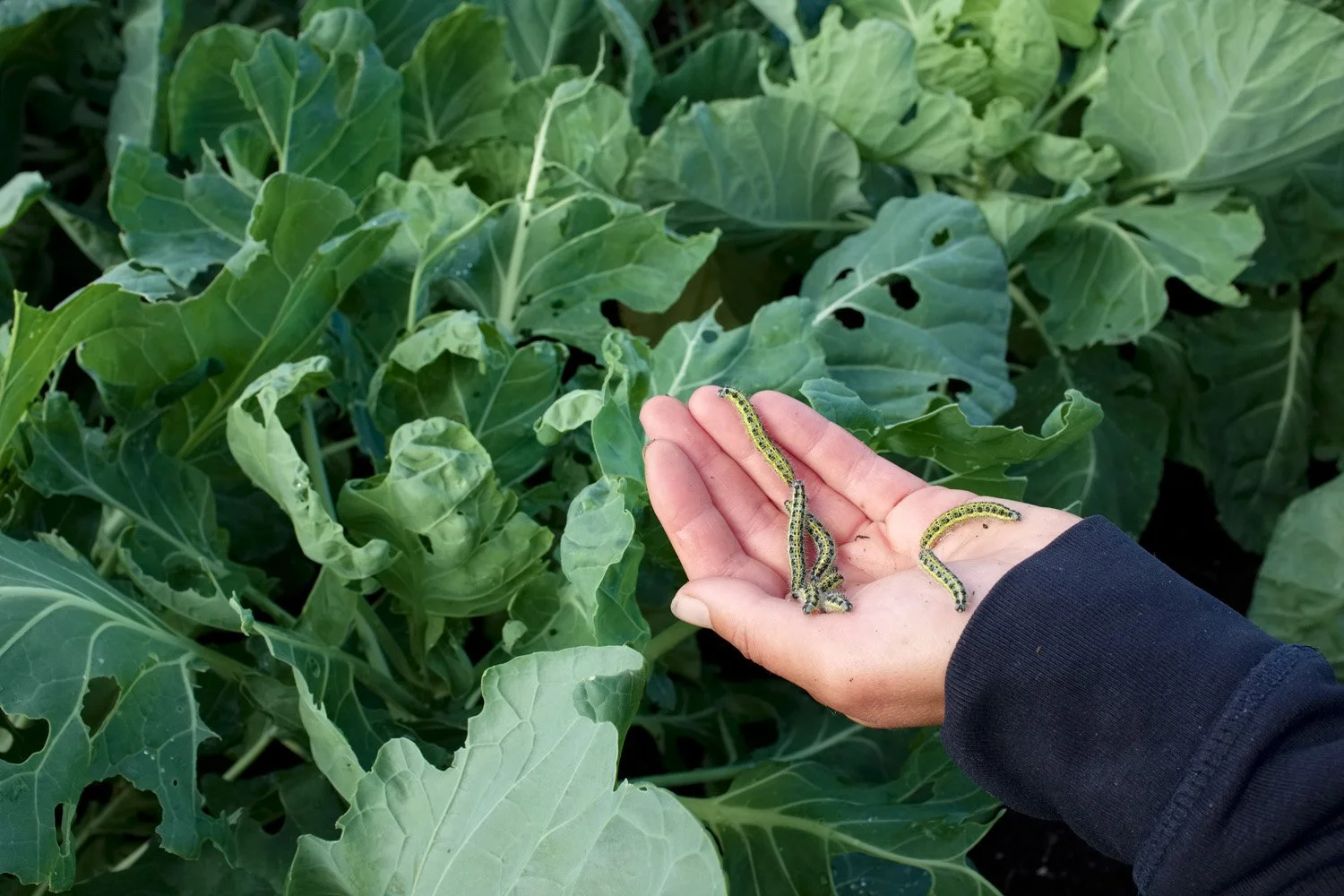
The flowers in the Proeftuin attract many butterflies, including cabbage whites, who deposit their eggs on cabbage plants. The gardeners pick the hatched caterpillars from the plants daily to prevent as much damage as possible to the vegetables. They do not use pesticides. September 2023
-
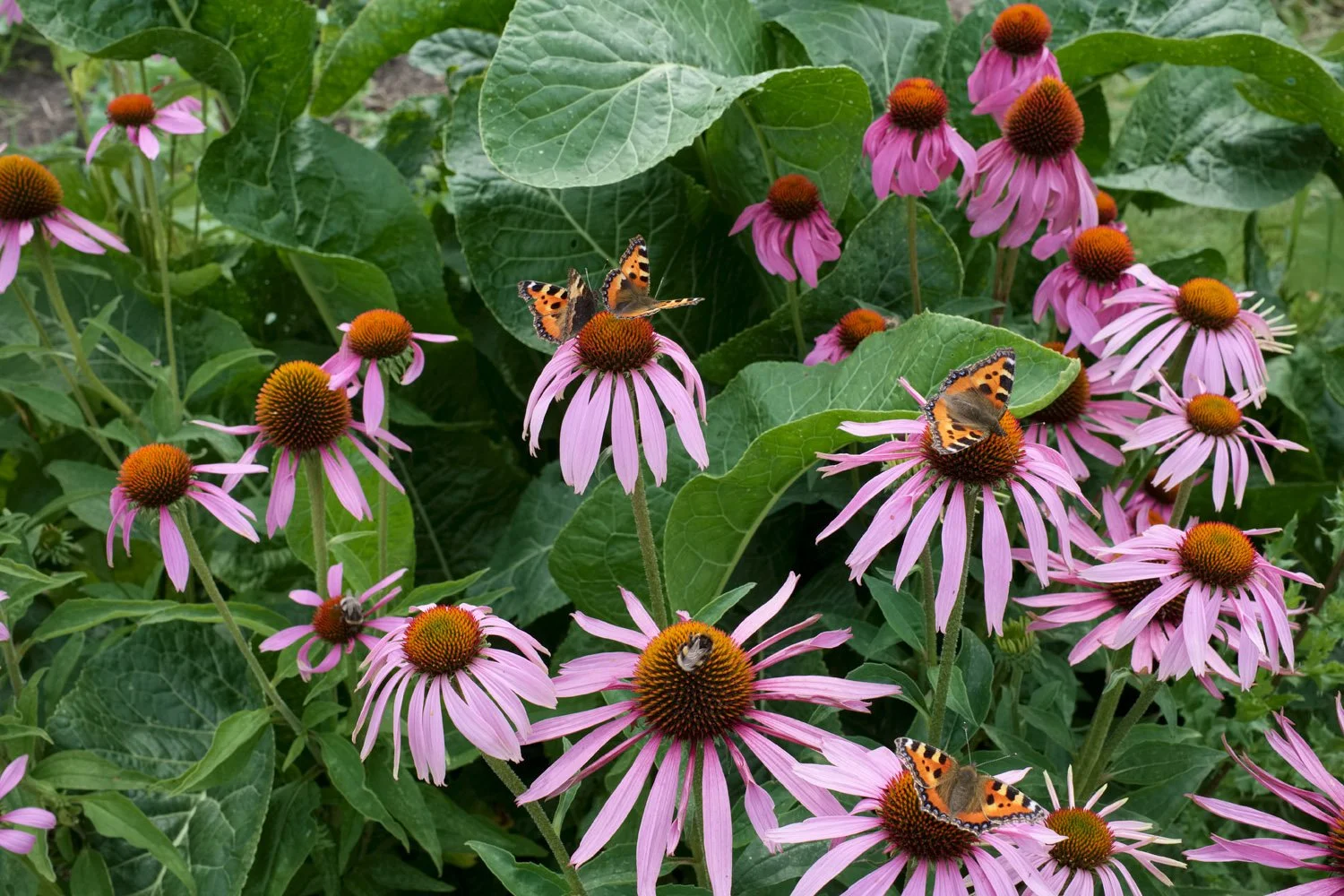
Small tortoiseshell butterflies and bees collect pollen from sun hat flowers. August 2024
-

The Proeftuin is prepared for winter. At the end of the harvest season, the plastic roof has already been removed from the tunnel greenhouses to prevent it from being destroyed in a storm. The frames remain. The left over plant matter of bell peppers (left and right) and malabar spinach (center) are spread over the cultivation beds. This is done to prevent the soil drying out from sun, wind and frost, and to suppress weeds. The crop residues slowly decay and thus also feed the soil and the life in it. November 2024
-
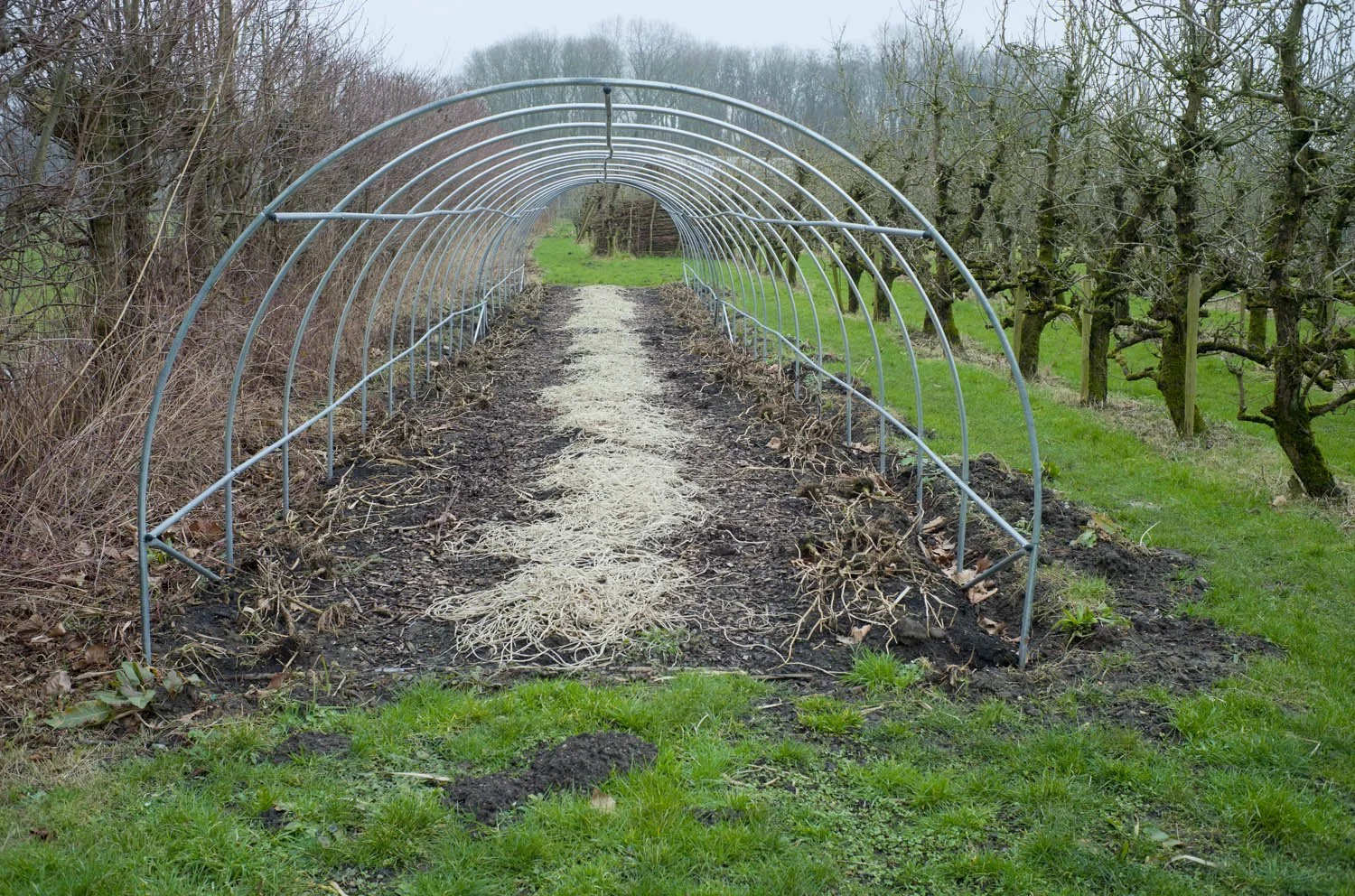
Three months later, the soft parts of the plant remains have already decomposed and only brittle branches of the peppers and white discolored tendrils of the malabar spinach still cover the ground. February 2025
-
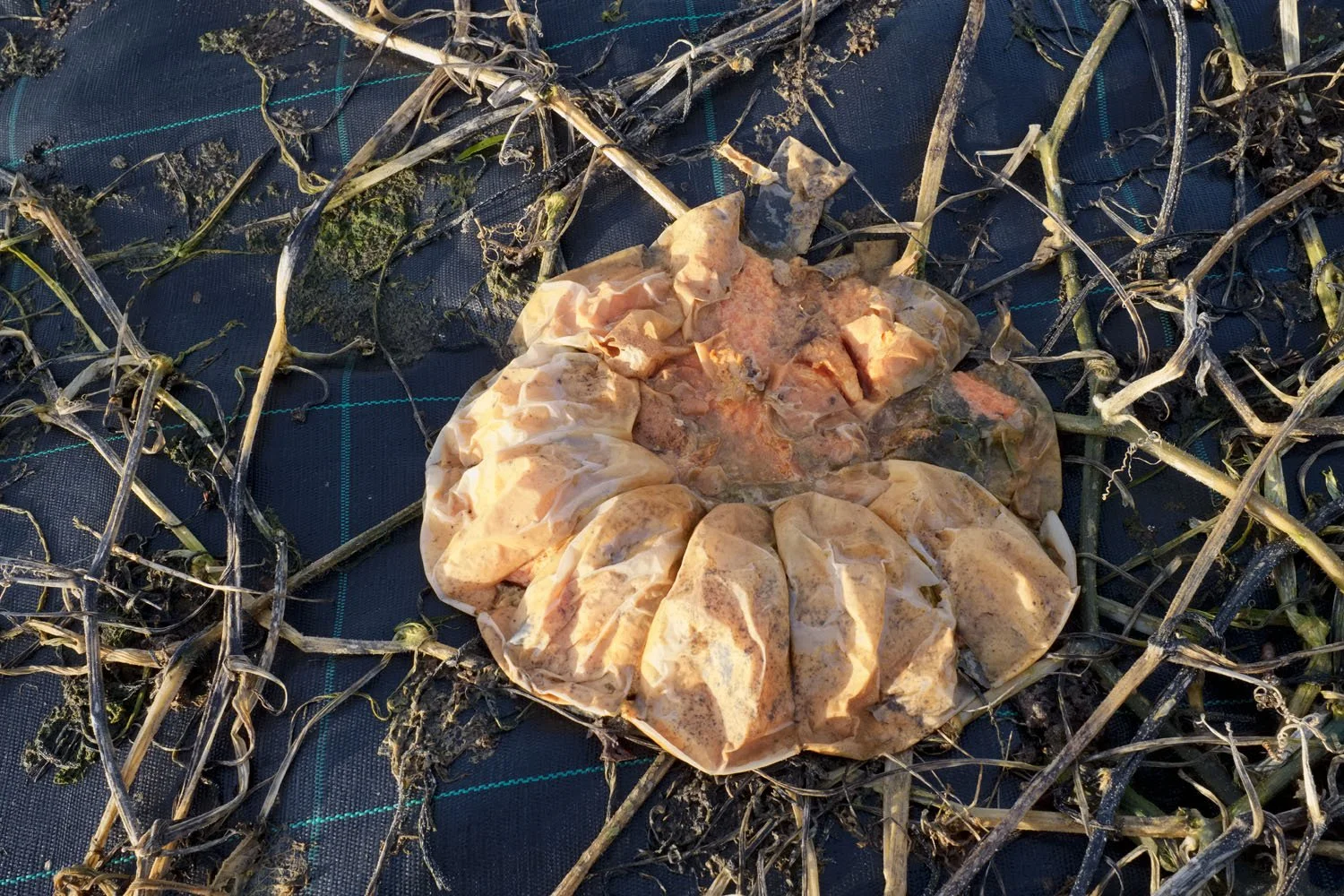
A decaying pumpkin. December 2024
-
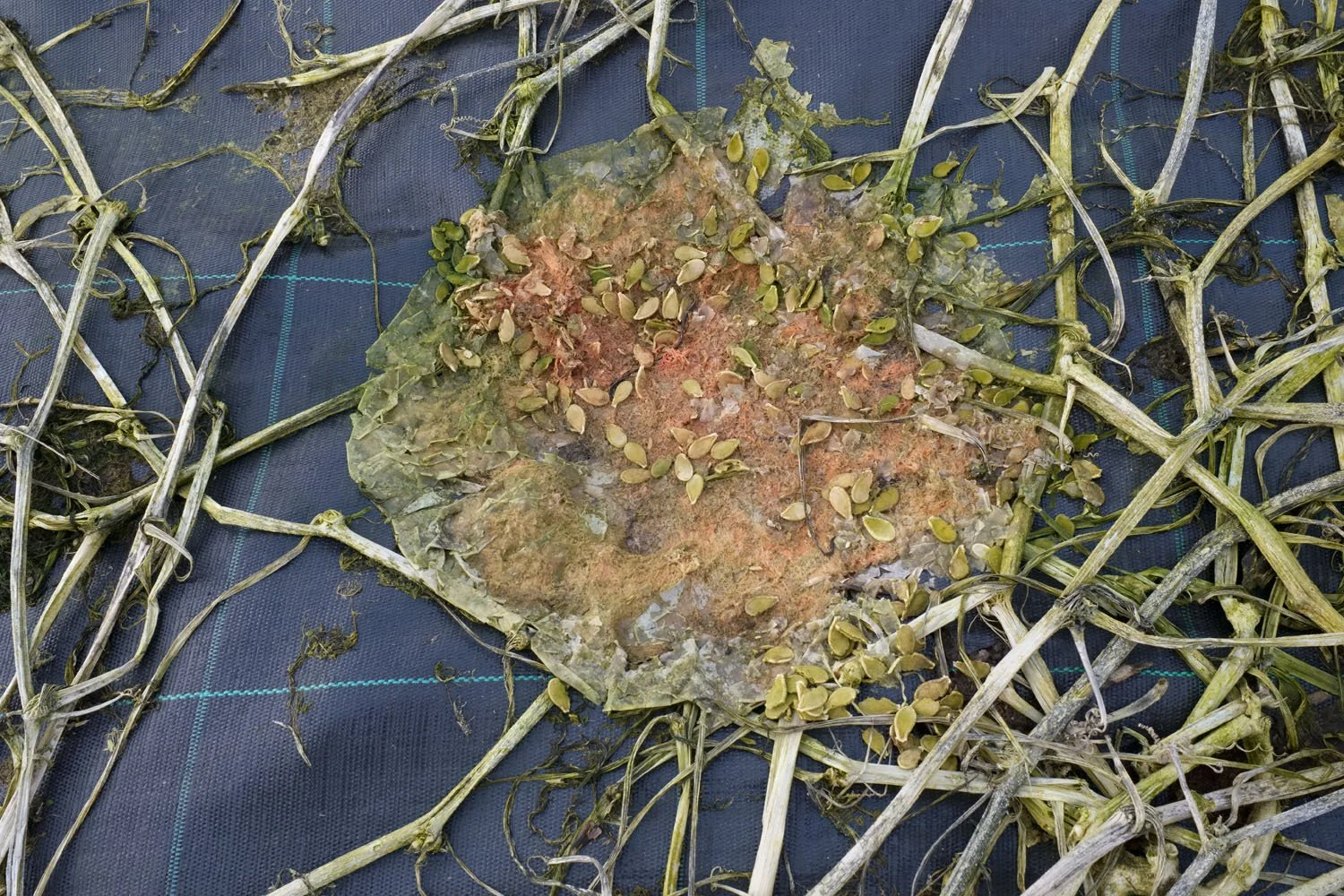
The same pumpkin three months later. February 2025
-
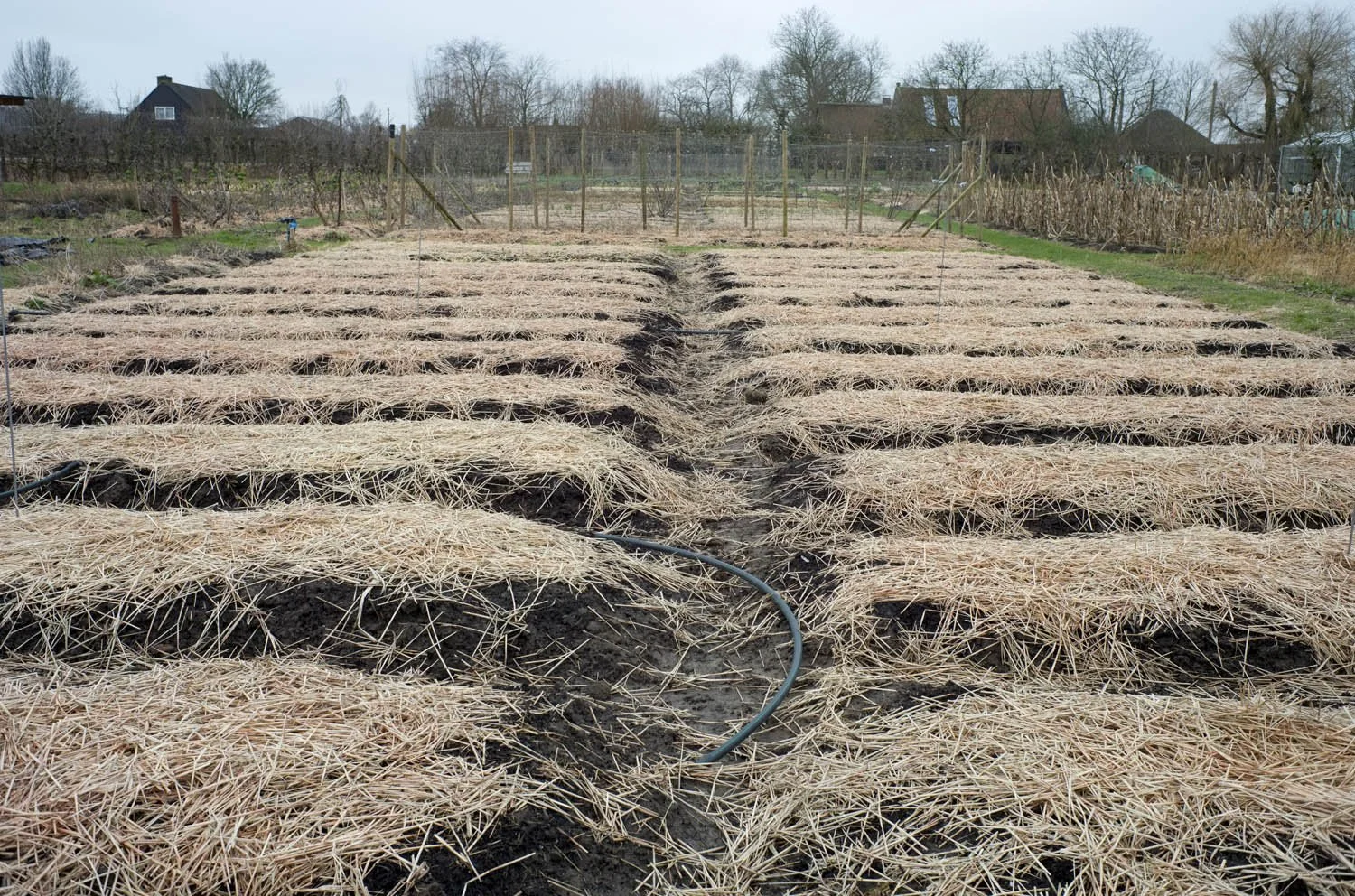
The Proeftuin van Linschoten at the beginning of a new growing season. Cultivation beds are still covered with straw. February 2024
Garden women
The women who run the garden all made the choice to switch to agriculture from other professions to make other people aware of the need for more careful handling of our earth.
Natascha Boel, who came up with the concept of the garden, takes care of everything that has to be done apart from cultivation. Her past as a legal expert comes in handy when writing grant applications, reviewing regulations, talking to civil servants and organizing many other practical matters. Her artistry is reflected in the beautifully illustrated website and newsletters, and in the tasteful interior of the guest houses. And she gives yoga classes in the big greenhouse.
-
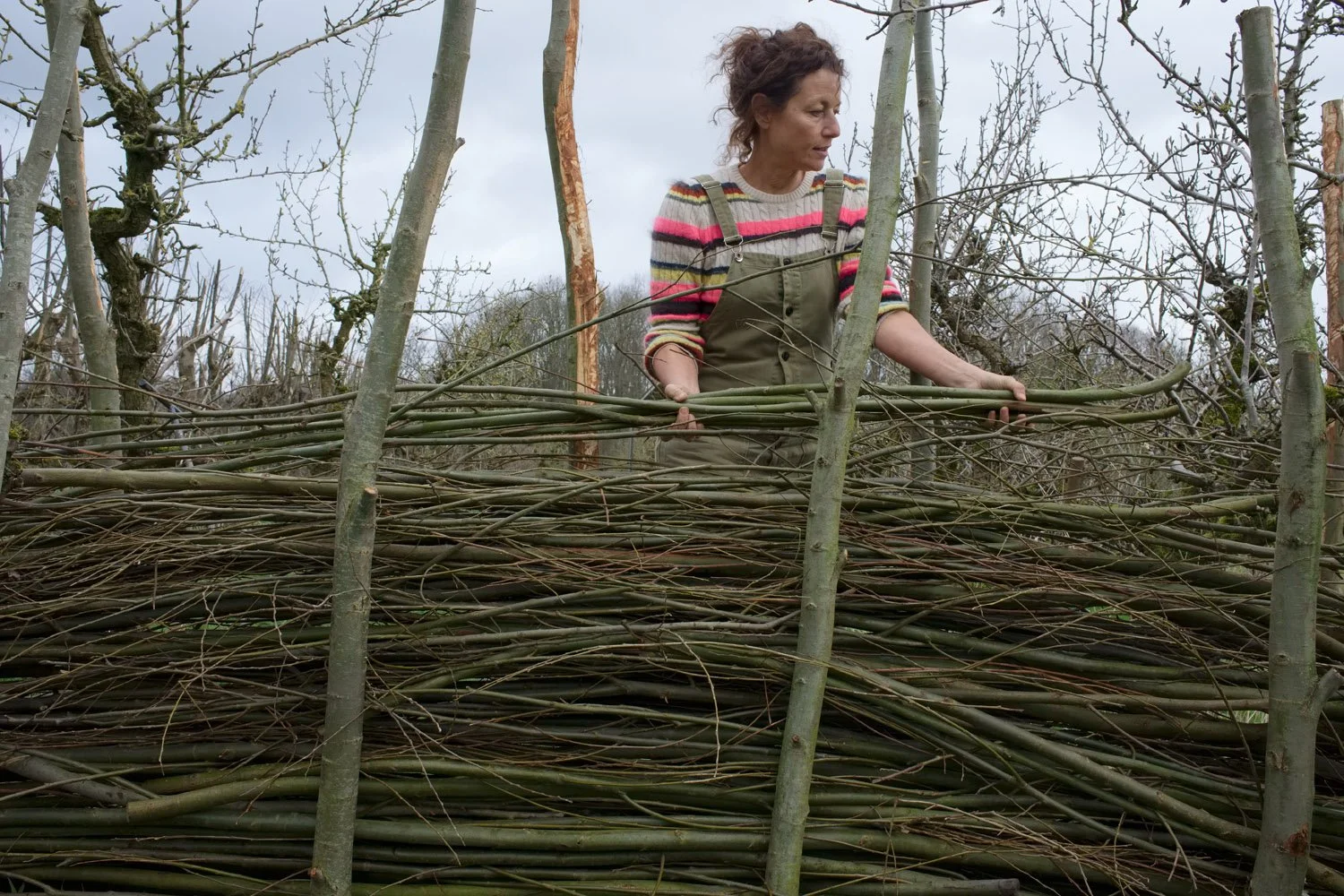
Natascha builds a screen of branches from newly pollarded willows. It will give more privacy to tenants of the holiday cottage behind her and also offers a shelter and nesting place for insects and birds. March 2024
-
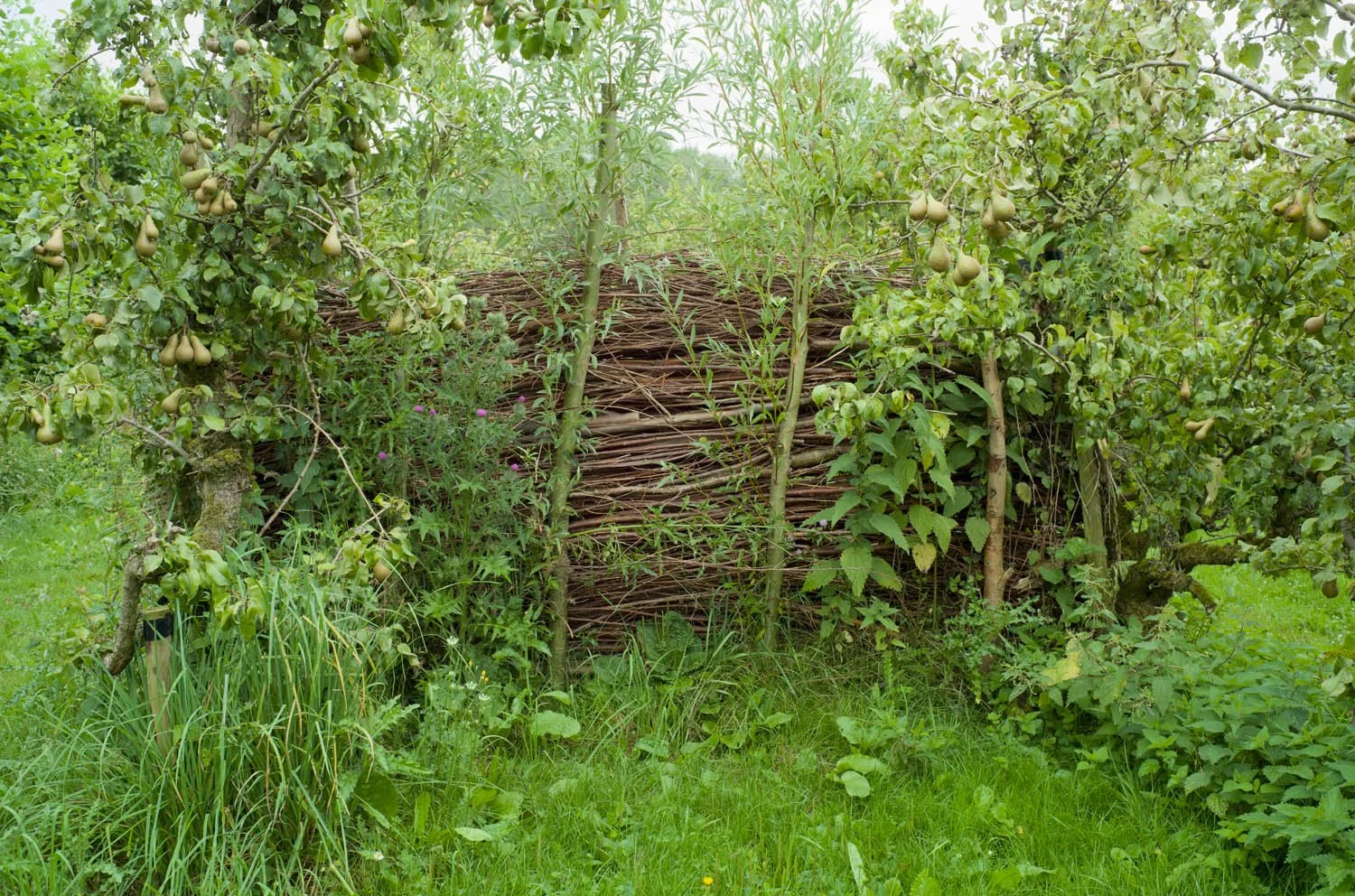
The screen that was braided of willow branches sprouts leaves and the pear trees bear fruit. Juli 2024
-
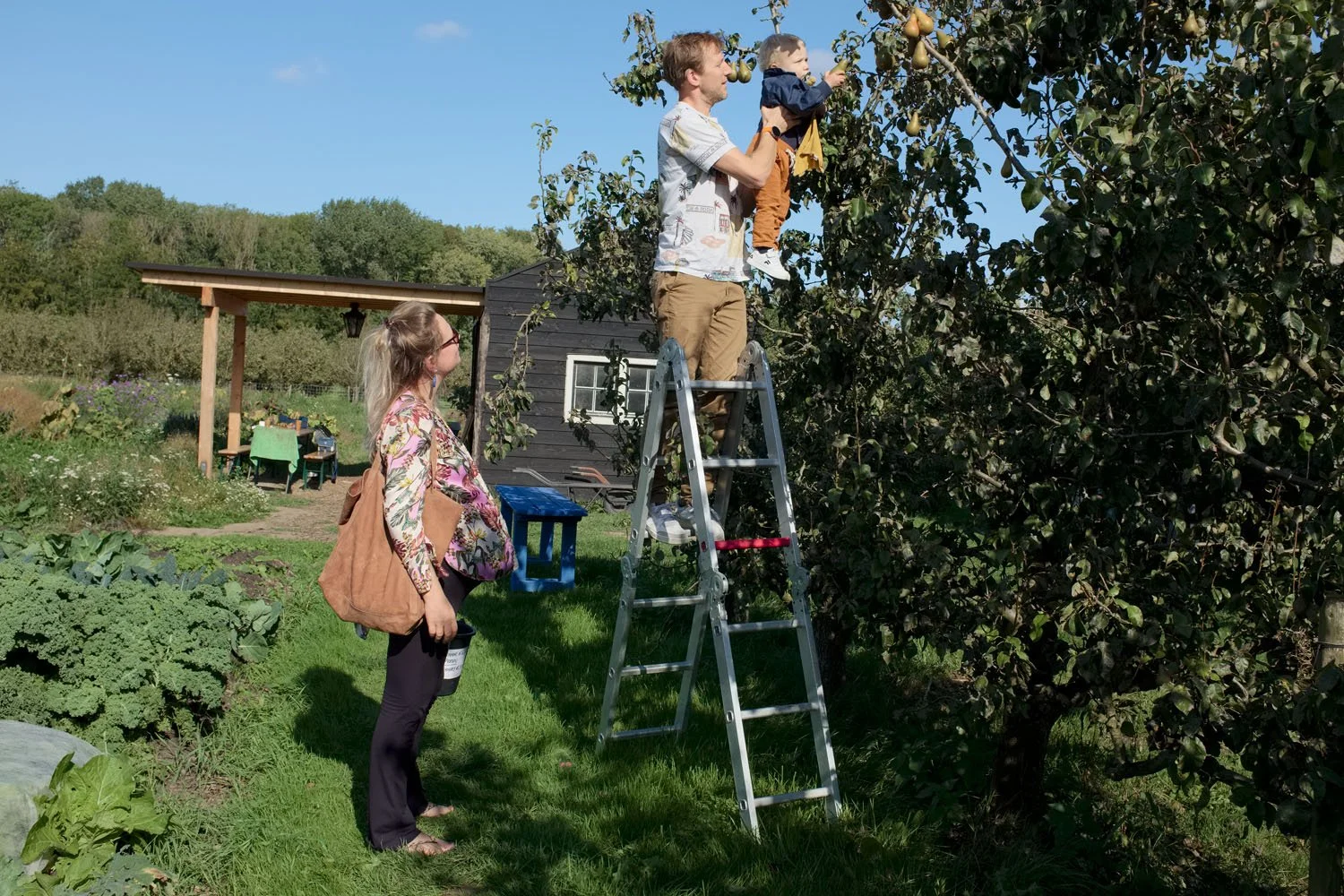
A father helps his son picking pears. The family visits the garden during a bicycle tour. September 2023
-
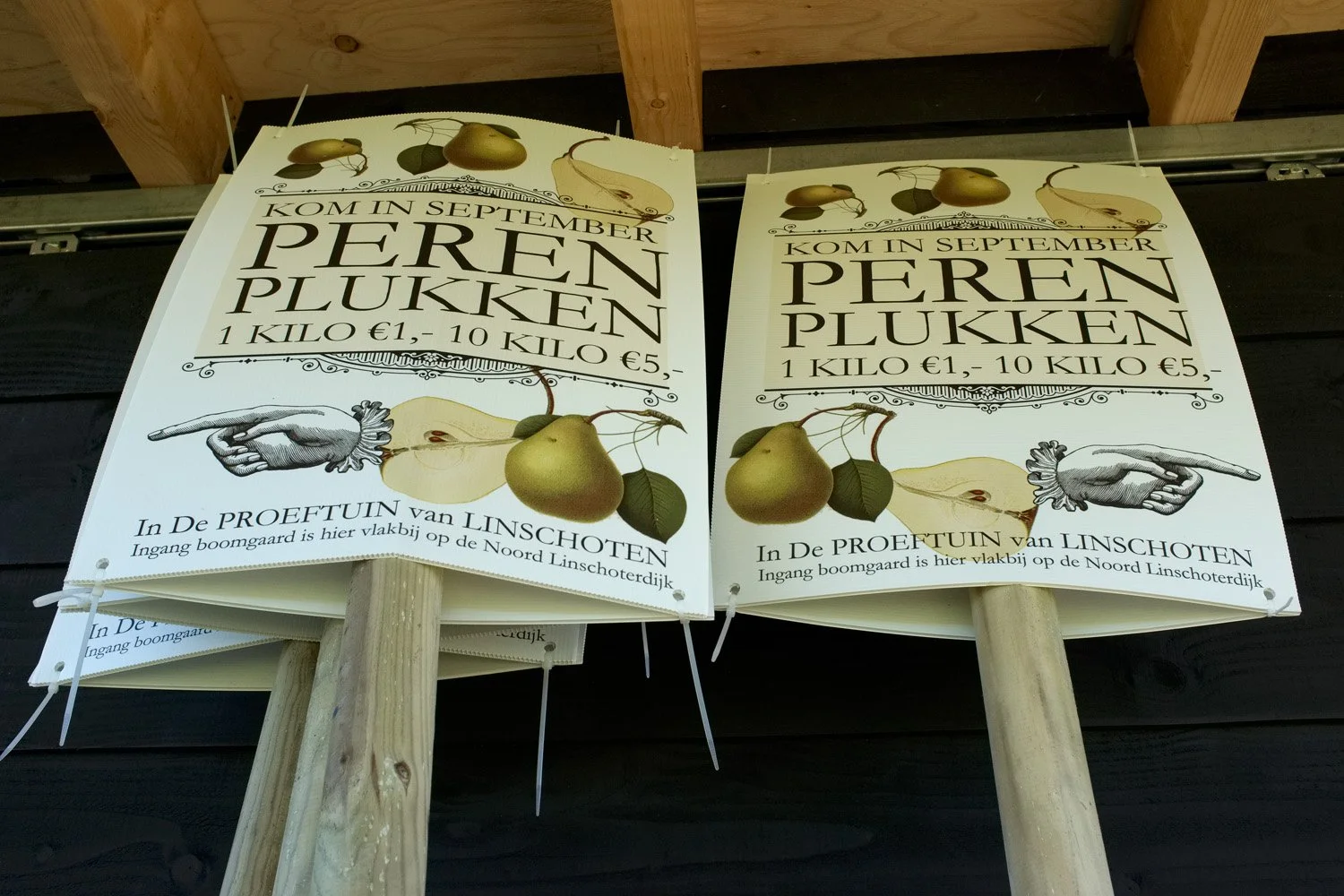
Natascha designed billboards that are placed along the road near the Proeftuin inviting passers-by to pick pears all September in the remaining part of the old orchard. September 2023
-
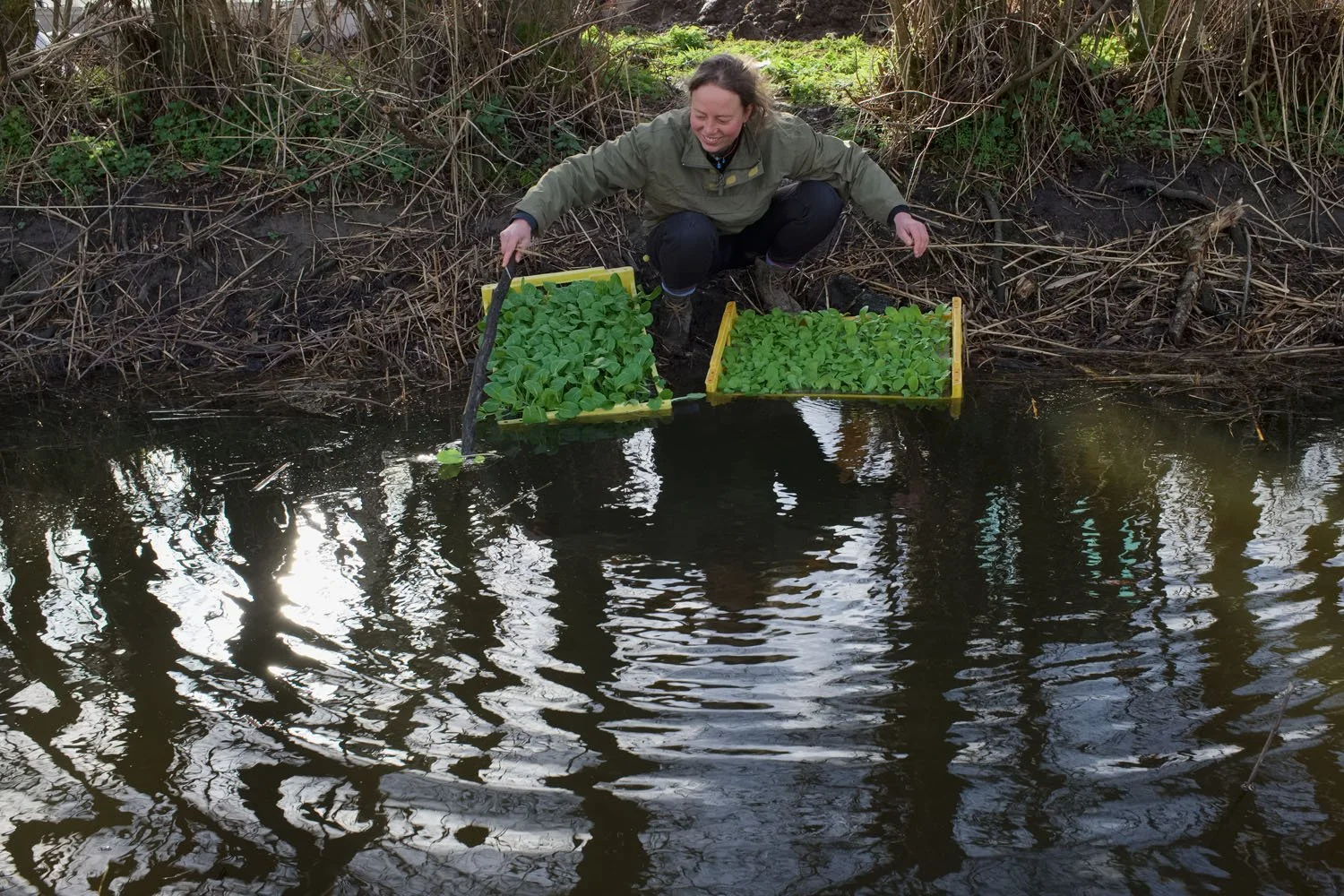
Until the irrigation system is installed, gardener Matty soaks grow boxes full of seedlings in a ditch adjacent to the Proeftuin before planting them. With a stick she retrieves a celery plant that has floated away. March 2023
Respond flexibly to what every season brings
After she studied sustainable food chains, gardener Matty Vink had two office jobs: as an organic certifier of farms all over the world and as a certifier for agriculture with the biodynamic Demeter quality label. That was the way she wanted to go, she had decided: sustainable agriculture.
During her training she learned how to help small farmers in developing countries, with a piece of land and a few coffee bushes or cocoa trees, to seize more power in the chain of distributors, exporters, importers and consumers: through cooperation, sustainable production, and organic certification or fair trade.
There was a lot of idealism. “We analyzed documentaries about the agricultural situation in Africa, Asia or South America, learned how to scale up production there. But then I also found out that agriculture in the Netherlands is one of the most problematic sectors we have when you look at climate change, the nitrogen surplus, fertilizer leaching and the use of poisons. We are very proud to be one of the largest agricultural exporters in the world, with such efficient production when you look at the harvest that comes per hectare of land. Why is this the ideal image that we have to copy somewhere else? That's not right! I realized: I don't have to go anywhere else with my idea that I know better. I can work in the Netherlands to improve agriculture.”
During the Covid pandemic, she decided to turn words into action, although she had no idea how she could work in sustainable agriculture herself. “You generally do not find vacancies for an organic horticulturist on a job website.”
But shortly after completing her two-year part-time horticultural study, in 2022, Matty already worked at the Proeftuin as an agricultural worker. After the departure of gardener Gennaro, Natascha asked if she wanted to become one of the permanent gardeners in 2023. With that, she suddenly got her “dream job” thrown into her lap.
Now, in her fourth cultivation season at the Proeftuin, Matty still cites her job title with a certain awe and surprise in her voice: “Head gardener!”
“Garden boss,” she laughs, with cheerful self-mockery. “Everything was new to me at first; it made me unsure whether I could do it. Which makes sense when you start a new job, let alone a new profession. Being challenged is nice, but at the same time, if something is a dream, the fear of failure increases, because then it is much worse if you fail.”
It was also, after the 2022 trial year, the first growing season in which they actually grew vegetables for subscribers. So Matty often wondered: ‘are we going to make it, is this going well, are we going to produce enough, are those people satisfied’?
“Those office jobs were also challenging. That's kind of a common thread in my life. Somehow I get into situations where I get thrown into the deep end. I'm not avoiding it. But before, I didn't have to think so much about what I did in the Proeftuin. Simply: harvest beans, weed, prepare a bed. Now I had to put together a cultivation plan and think a lot and observe how things are. And I actually worried much more.
“On the other hand, it also gives more ownership of the garden and connection to the site.”
-
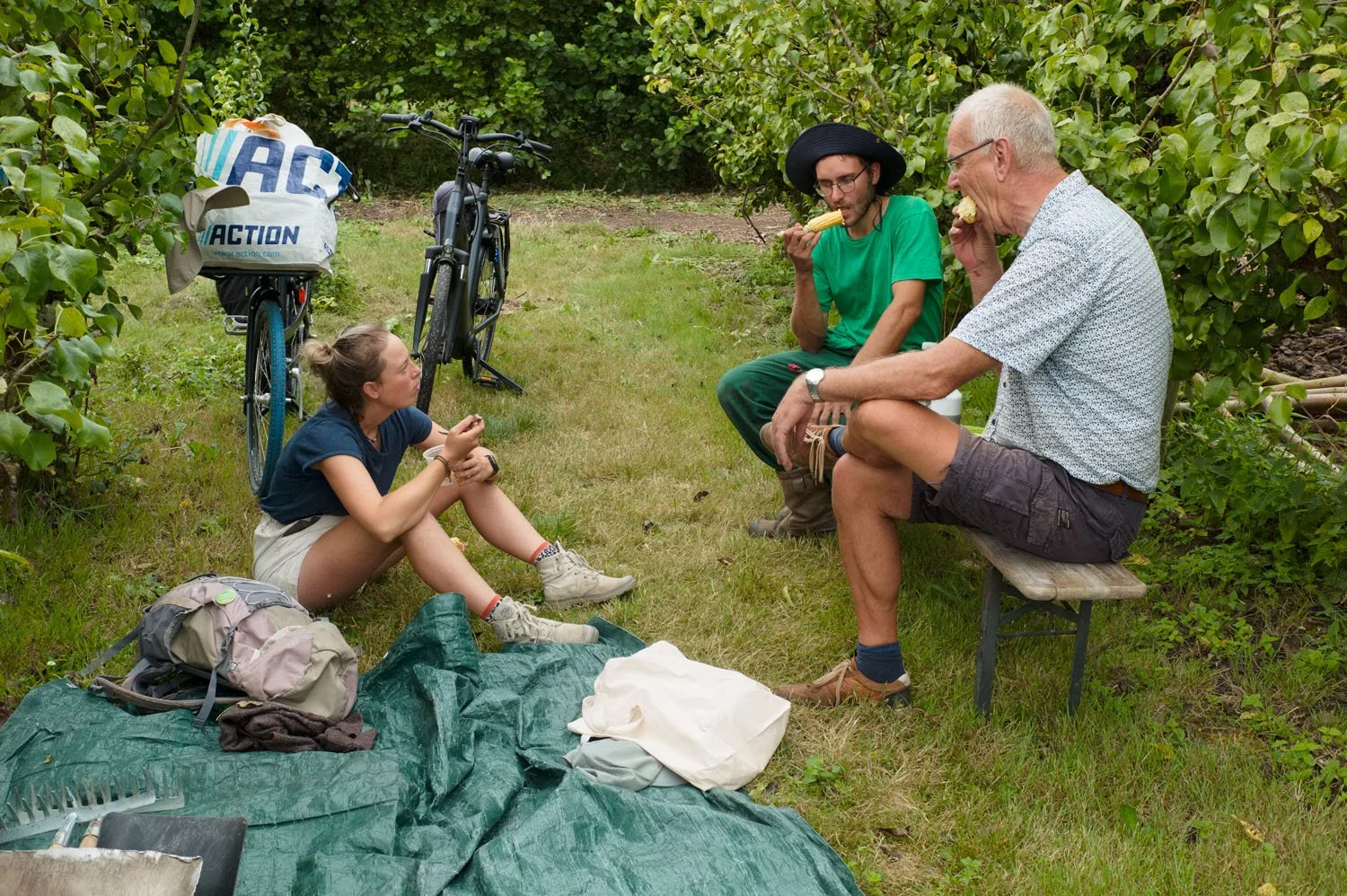
At lunch time, Gennaro and volunteer Maarten taste the first harvested corn. On the left Matty, then still working as a garden hand. August 2022
She made her first cultivation plan together with the other new gardener, Emma Smeets. “Nobody actually knew the idea behind Gennaro's cultivation plan. It was all super diverse and on each bed there was a completely different crop, and flowers everywhere in between.”
Matty and Emma introduced more structure “to make it easier and more efficient for us. We put the plant families together and also made a very tight timetable. On each bed there are at least two different crops in succession, sometimes even three. I think Gennaro did a lot more from intuition, we from planning. We wrote everything down and worked it out in a spreadsheet. It's not just in our head.”
Meanwhile, with more than two years of practical experience under her belt, she knows: “You steer where necessary, but in principle everything grows automatically and you can trust that it will be alright. You are always getting surprised, by weather conditions, the vagaries of nature, but I notice that I now respond more flexibly to what every season brings. I have found more tranquility in the profession and I also get more satisfaction and pleasure from coordinating and organizing everything.”
In addition to producing food in a sustainable way, the social and educational aspect are also important in this market garden. ”I had not realized before,” says Matty, “that our way of horticulture also affects other facets. That volunteers like to cooperate. People come here to harvest and are more connected to the food they eat, and their children see how everything grows. It is a place where you are welcome, also to just sit if you want. To find peace or excitement and fun: a chat or a tasty carrot. It also brings me a lot as a gardener, the joy of those people. I experience the garden again through the eyes of all visitors. Then I want to do my best to make it beautiful as an experience place, instead of just as a production place.”
-
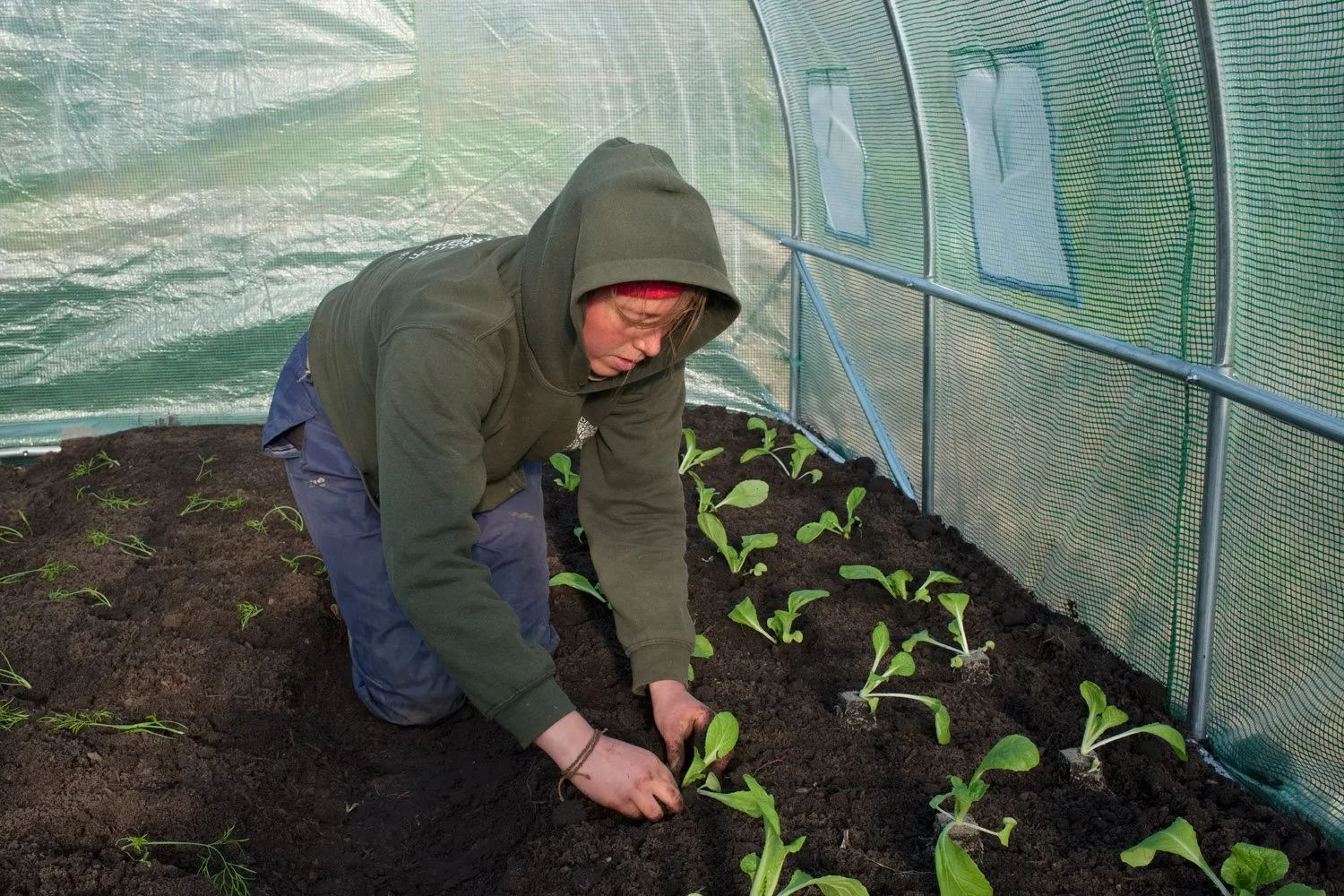
Gardener Matty plants peppers in one of the tunnel greenhouses. When the weather is still bleak, vegetables can already be grown here, which extends the growing season. March 2024
-

Matty and volunteer Ineke build a bamboo rack for the heirloom holy beans. The bamboo sticks they ordered came in late, so the bean plants are already quite large and their shoots need to be disentangled in order to wrap them around the poles. A tricky job, because the tendrils are fragile. August 2024
-
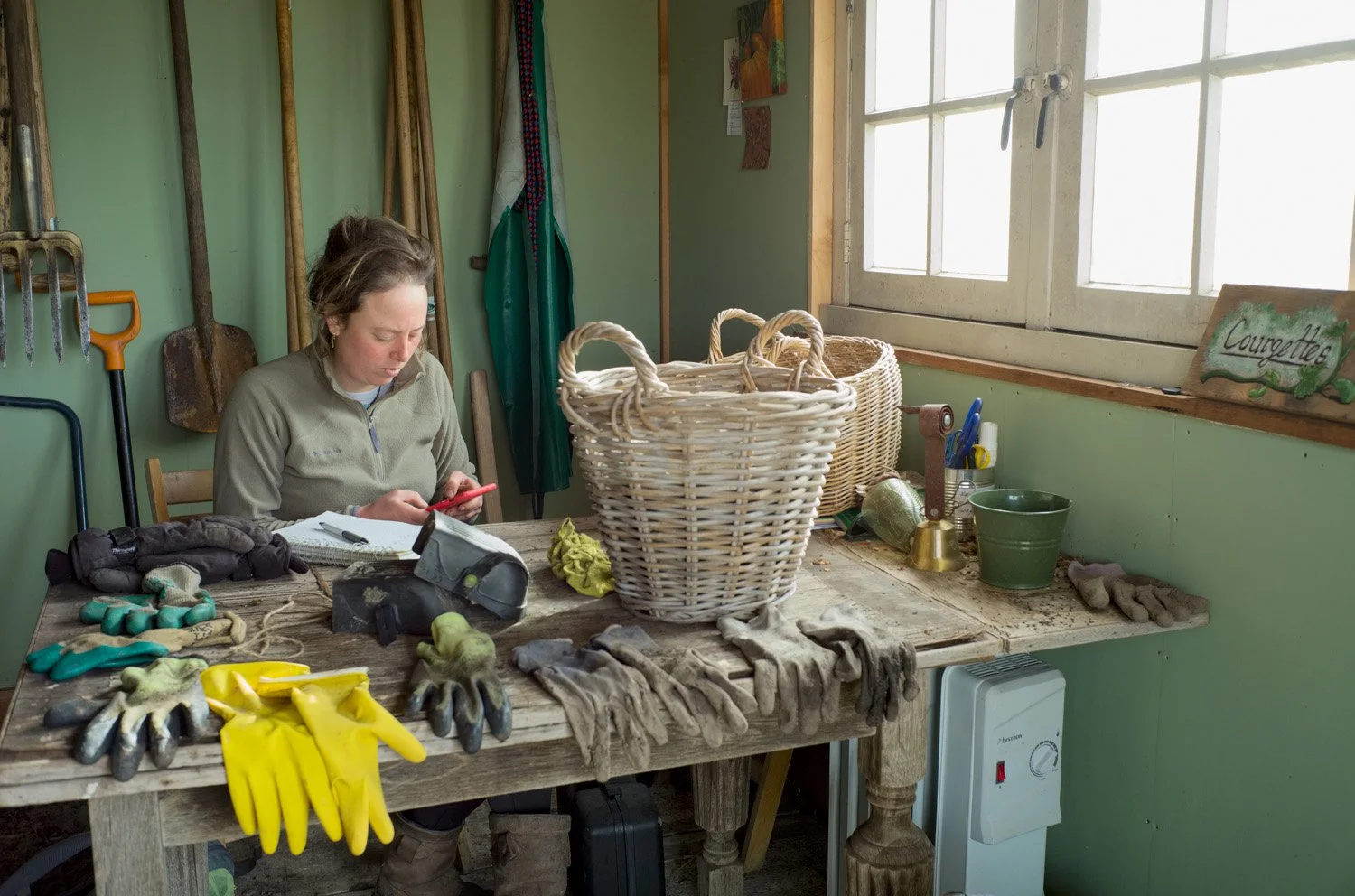
Matty checks the cultivation plan on her mobile phone in the work shed. Her new colleague Jantien, who joined the garden team in the 2024 growing season, first sorted all garden gloves. February 2024
-
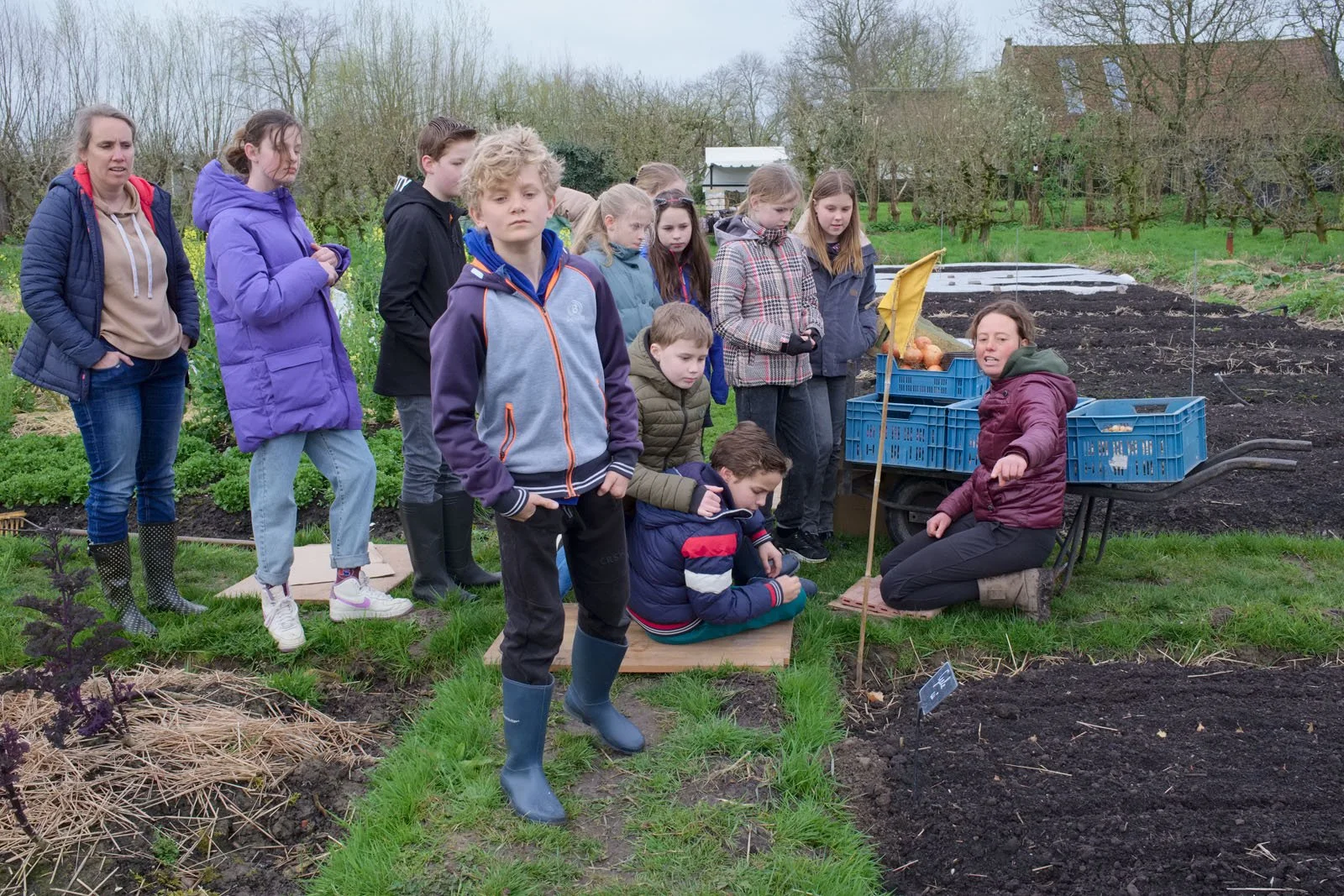
Students and an accompanying parent of the Margriet School in the nearby Dutch town of Woerden visit the Proeftuin van Linschoten. They learn about growing vegetables and biodiversity. Matty (right) shows how to plant onions. The students will then to do this themselves. April 2024
-
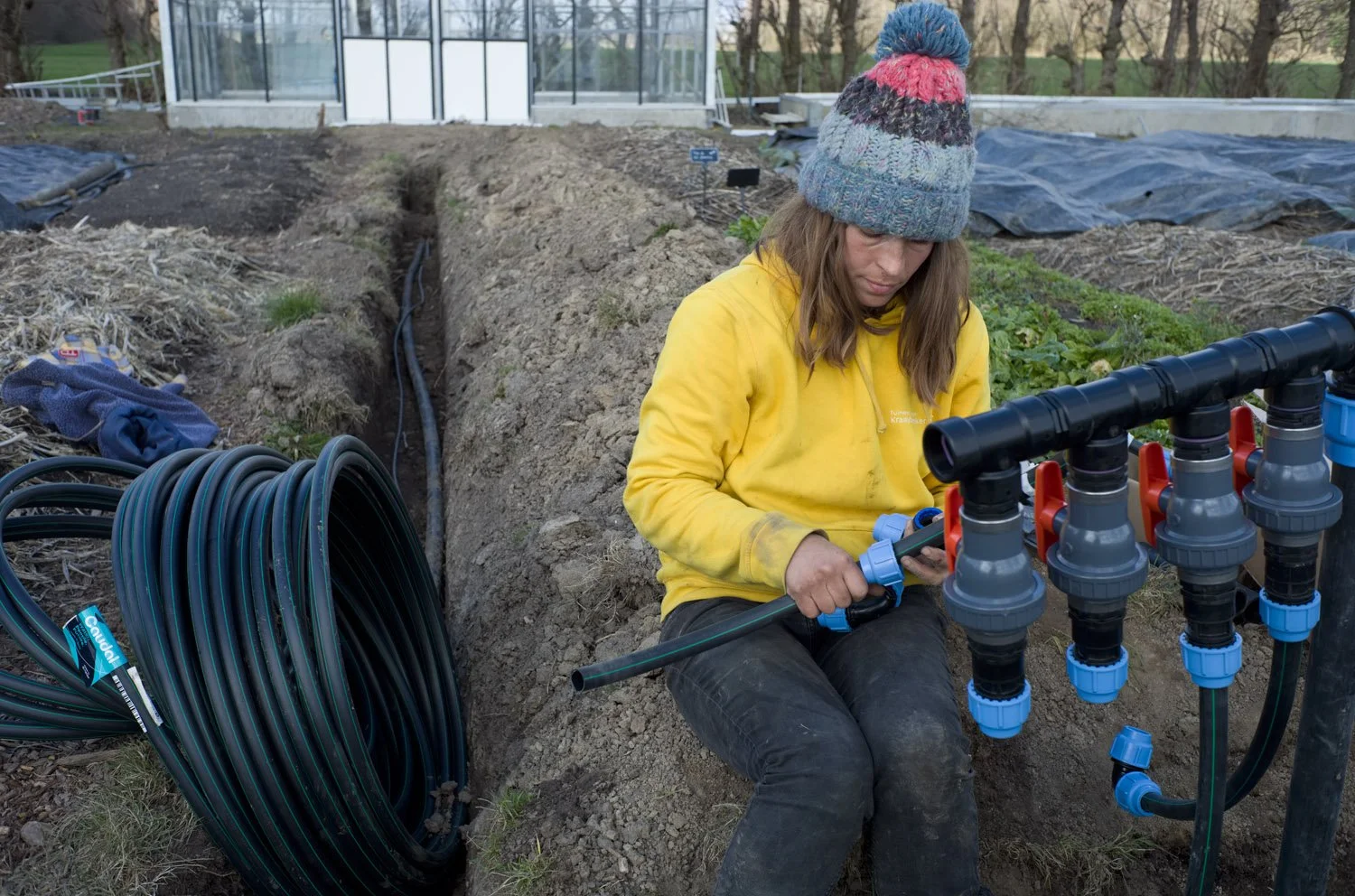
Gardener Emma installs the flow system for nozzles and drip irrigation. Long channels have been dug into the river clay throughout the garden to install underground water hoses and electricity. March 2023
Hard core on the critters
Emma Smeets used to be a family doctor. She made the change from health care to market gardening "because I realized that I am of the last generation that can still reverse a skewed world that has been stable for 10,000 years. As gratifying as the work as a family doctor is, I thought: if I do this for another forty years, I will be on the sidelines, it will not make me happy. And if you want to do something for the environment in the Netherlands: 70 percent of our non-built-up land is agricultural land, and everything nature needs is space. Buying and rewilding land is the best thing you can do, and farming sustainably is great too!
"It all used to be so beautiful here - if we can shift it back that way just a little bit, we can guarantee both ample production of more healthy, more nutritious food, and give nature some space." She refers to the period before large scale redistributions of Dutch agricultural land, when there were many small, mixed farms that used their own manure production for crops instead of fertilizer.
Emma also works in another vegetable garden in 2023, Groentepark De Bontekoe in the city of Leiden, which is much different. "We are in the middle of a deprived neighborhood in the center of town, between an environmental park, a sort of industrial place, and the Food Bank. We grow for them. There we are on sandy soil, very different from here, and we really don't have any money to spend. We are dealing with local residents who have opinions on what we are doing on municipal land - those who are not happy with it shout the loudest. What I like there is that we are very much the underdog. We have many young volunteers who really do it for the good cause, which gives a very united feeling."
-

Emma sows spinach with the seeder. It is one of the few machines in the market garden and even it is powered by hand. September 2023
-
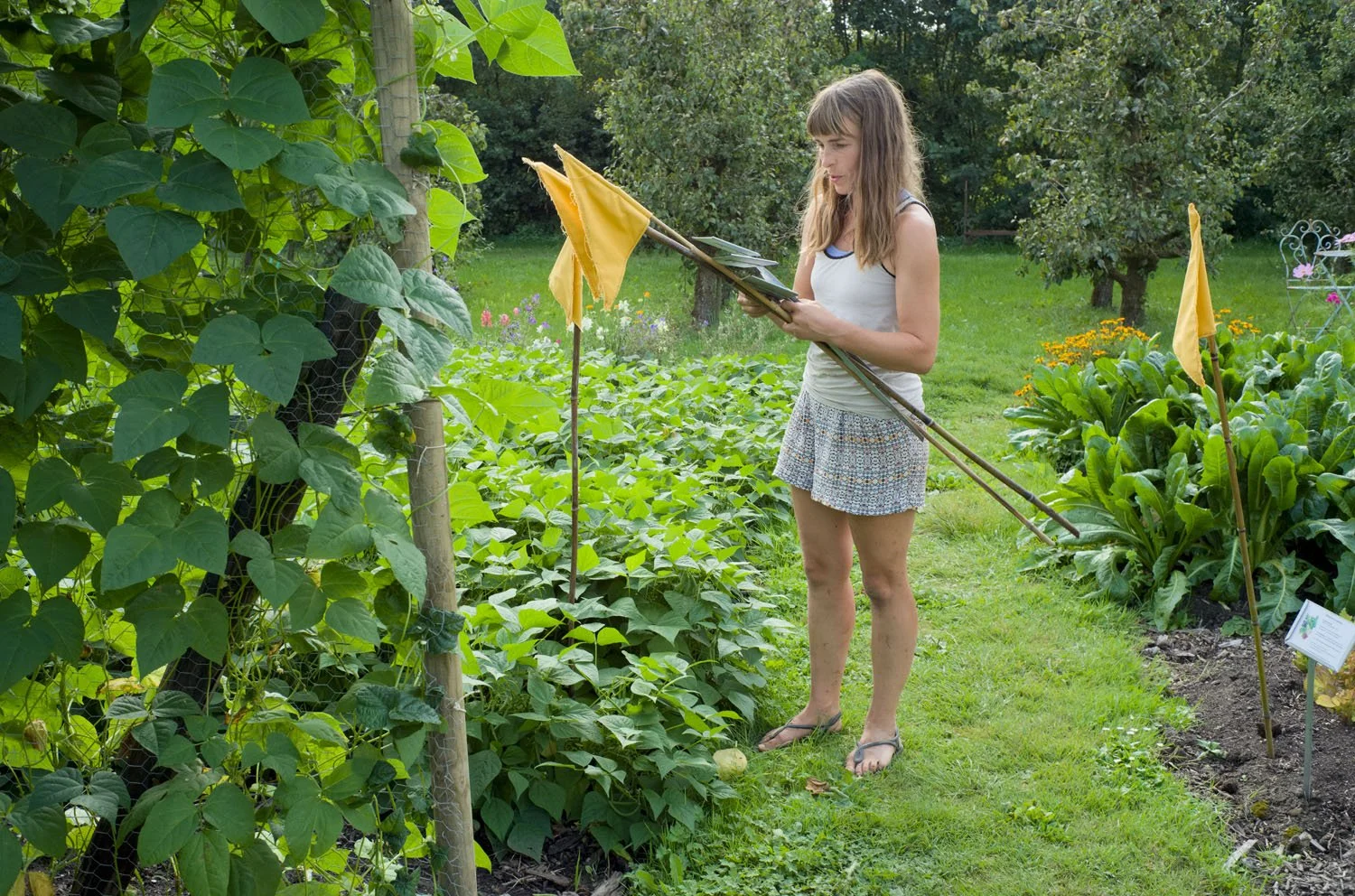
Emma places yellow flags so that the vegetable subscription holders know where to harvest their weekly vegetables. Signs explain the crop and the best way to cut or pick. September 2023
"What I like here is that the range is wider. I can tell more people the story of this garden, what we do and why we do it. And the ecological impact is higher, whereas on the social dimension it is higher in Leiden. The Proeftuin van Linschoten is in the middle of an ecosystem, I can enjoy all the birds and animals that fly and crawl by.”
Emma is, she says, “the most hard core on the critters”. She photographs the butterflies, caterpillars, salamanders, frogs and toads, and puts them in the newsletter with an explanation. As a little girl she had always been busy with nature and insects, but for a while she wandered in a different direction.
“For me it's really about showing what's going on in agriculture, what's the problem with fertilizers and pesticides, and what happens if you do it differently.” She decided to do a horticultural training, “because I can't advise on something if I don't know what I'm talking about.” She thinks that this is one of the main causes of the problem with Dutch agriculture: the gap between people who say it has to be done differently, and the people who have to carry it out. “Then you will not listen when someone in a suit stops by once again.
"What I actually thought was: if I transform one or two hectares of land that is now ruined into something beautiful somewhere in the world, that is a feasible goal and I can at least get direct satisfaction from that. And also make time to join a number of movements that look at a higher level, to see how we can better promote and achieve this nationwide. I want to be part of the bridge between the rural workers and the policy-making people.”
-
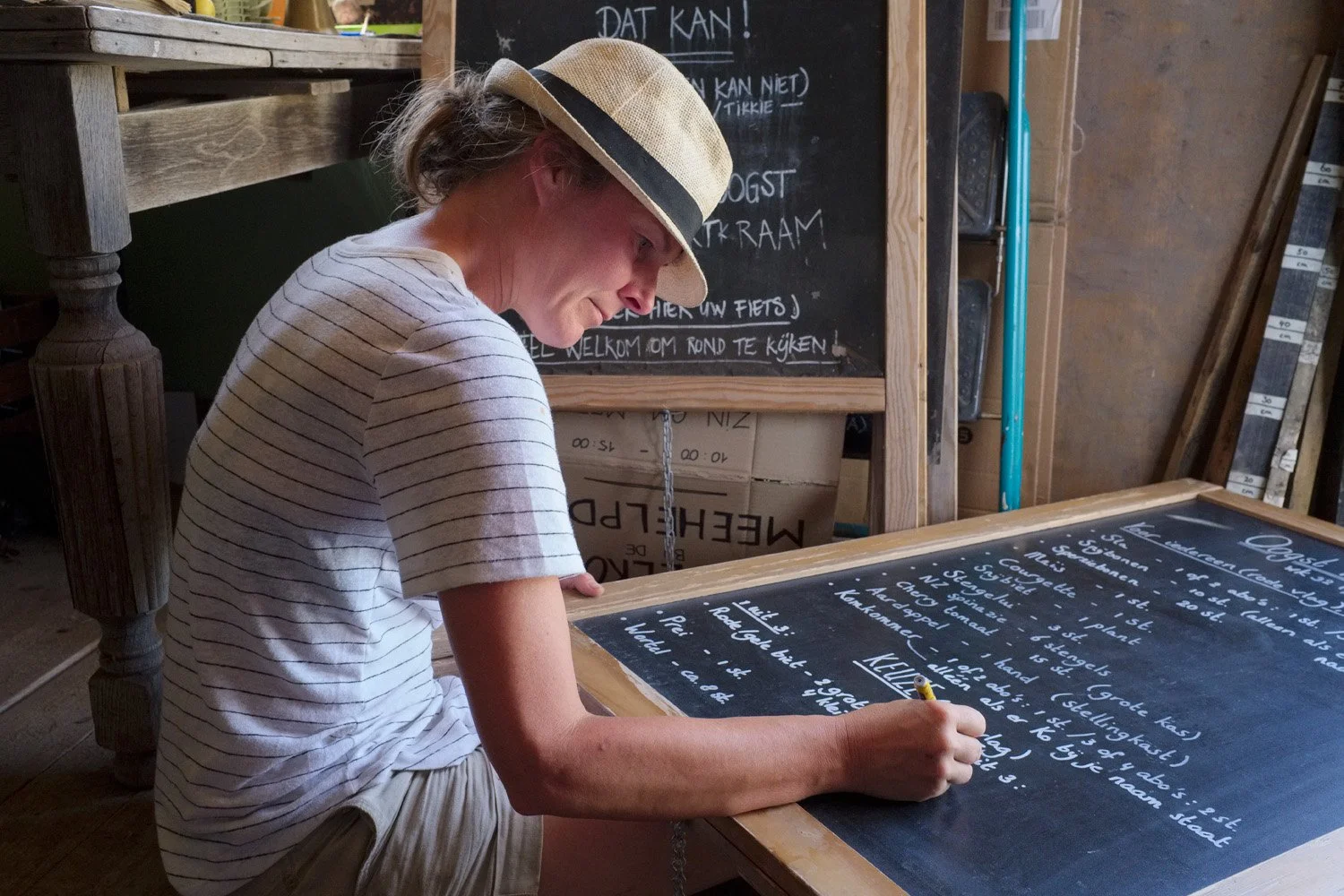
Gardener Jantien sits on the tool shed’s floor, writing a list of vegetables that CSA members can harvest, and the quantities allowed, on one of the information boards of the Proeftuin van Linschoten. August 2024
Healing land
When Jantien Meijer followed the part-time horticultural training at the Warmonderhof farm school, her grandfather, an arable farmer in the Dutch province of Zeeland, who grew potatoes, onions, sugar beets and grain, said: “O Jantientje, I like that!”
“That suddenly gave us a new kind of connection,” she says now. Because his granddaughter was a real city kid; born and raised in Rotterdam, she went to Amsterdam to study theater sciences and international relations.
“It is not that I developed my love for market gardening on my grandfather's farm. But I did get the outdoors experience there. The gardening gradually crept in. At some point I experienced severe trauma, was out of the running, but I didn't want to sit on the couch at home. Then I happened to come across that agricultural training. Not with the idea 'I want to become a gardener', but I wanted to learn that trade. Then I noticed how healing the land can be. There are care farms for a reason.
"And, what I had not anticipated: I really enjoy living with the seasons. That you build something in the spring and break it down again in autumn. That's so beautiful in nature, but it also touches us as people. It is nice to turn inward and reflect in winter.”
Jantien has been working at the Proeftuin since the 2024 growing season. The previous three years she was active at other market gardens. “This is an environment where I can land,” she notes as she glances around the Proeftuin in its late summer glory. “A safe place, where I can breathe, go outside and be busy. That is such an instinctive awareness: there is a softness here, a calmness, and space for each other, warmth, shared attention, listening. You enter and it is at once: ‘welcome’.”
-
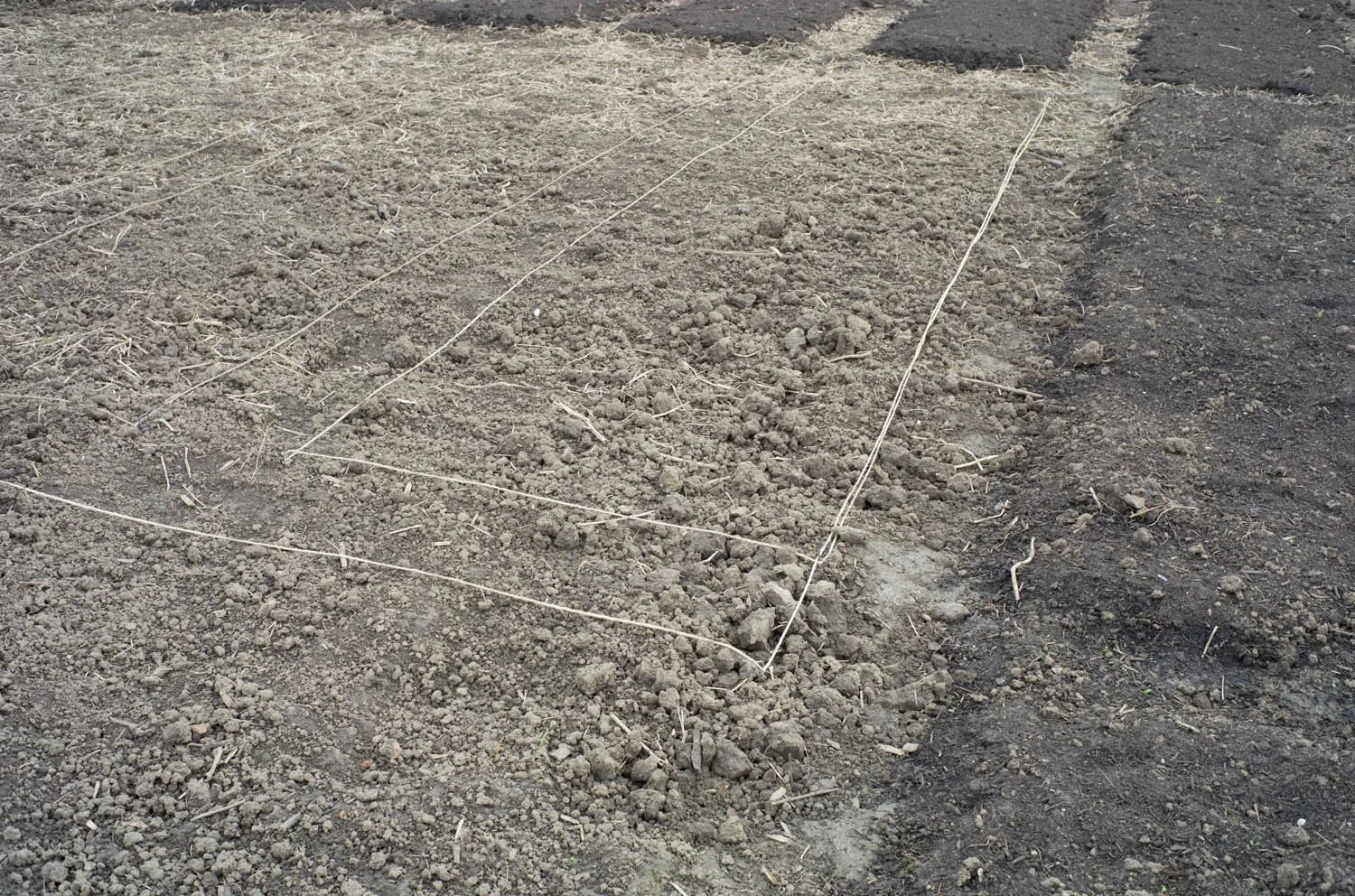
New growing beds have been measured out by the gardeners, marked off with rope. Now they have to be filled with a layer of compost. The narrow strips are paths that will be covered with wood chips. March 2024
-
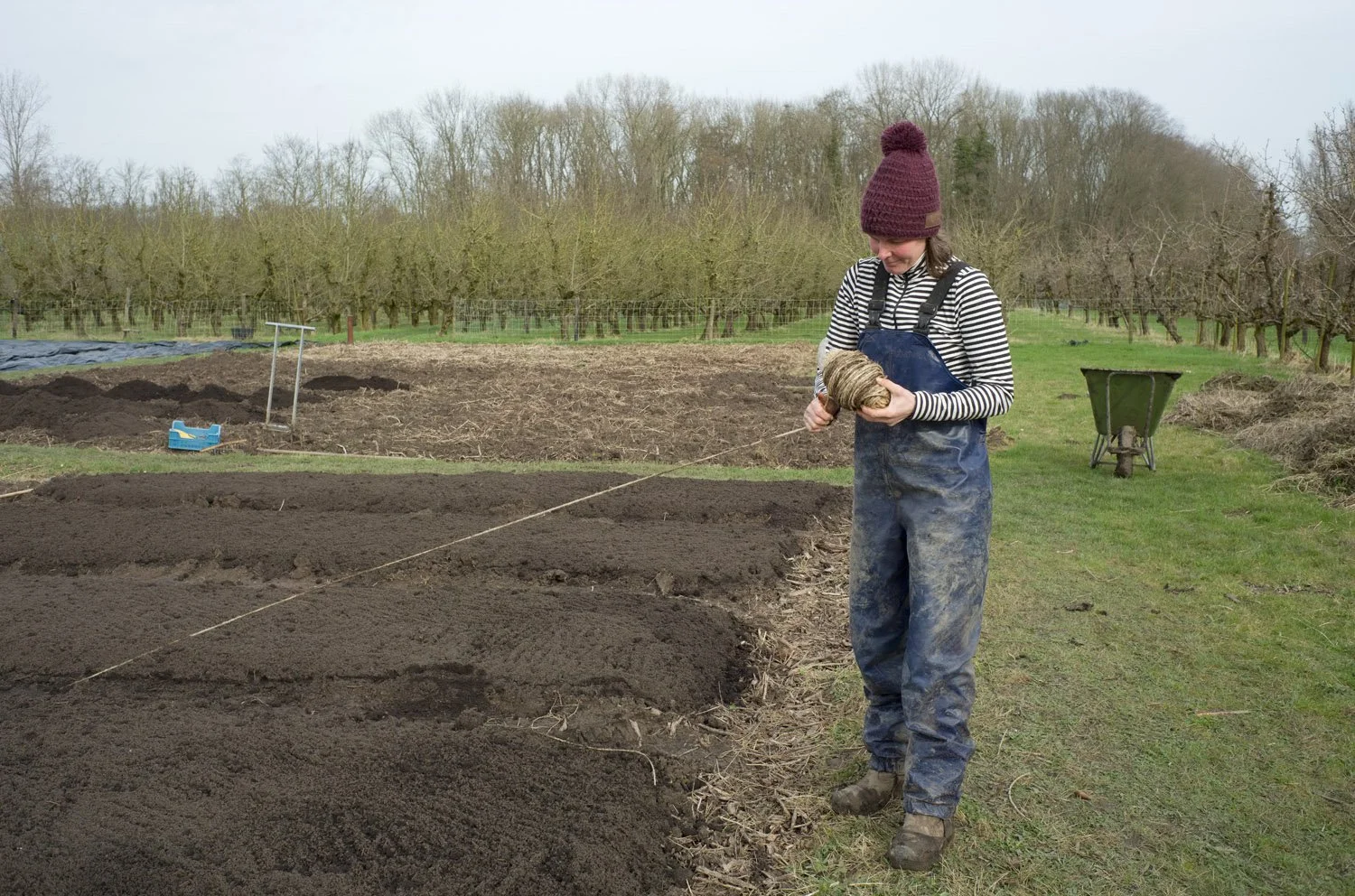
Jantien rolls up the rope with which she had indicated the new beds. Those are covered with compost and ready to plant potatoes in. February 2024
"The overarching goal of the garden is to work on an alternative to the common food system, with attention to how nature works. A way of producing food that does not harm the world, but preferably makes a positive contribution to it, in a way that is also profitable. Because it is not a hobby, it is also a company. Meanwhile, while doing this, I also think: we are only a tiny postage stamp. Still, if you have many stamps all over the world, that's quite a lot.
"And it is not only about the vegetables that come from that land, but also about the impact that production has on the world. I find it fascinating to dive into what is happening in the soil, how it can also capture CO2, for example, and how this is related to the climate issue. This really matters, we are all dealing with this. And it has a certain complexity, so much comes together: nature, chemical processes, biology, biodiversity. And the personal: people come to the garden, to volunteer or to self-harvest. What role can such a garden play in a healing process, both for the earth and in social contexts? I find all that valuable. And also what you don't see here: there is a network with other gardeners that connects all those postage stamps, and that can again become an ink stain that spreads through knowledge transfer.
"This is only my fourth season that I fully work as a gardener and there is a hunger in me: there is so much that I have not even touched yet. This is something for the long haul, one of those things that you can do all your life and you will still learn.
“What captivates me about the soil is that so much is still unknown. On the land it seems to be the key to everything. Why on earth would you till if that brings weed seeds to the surface and bacteria and fungi can provide the desired structure very well? We really only need to give space to those natural processes. We are so focused on keeping everything under control. I like to observe and follow. Because who am I to think that I can grow vegetables better than nature.”
-
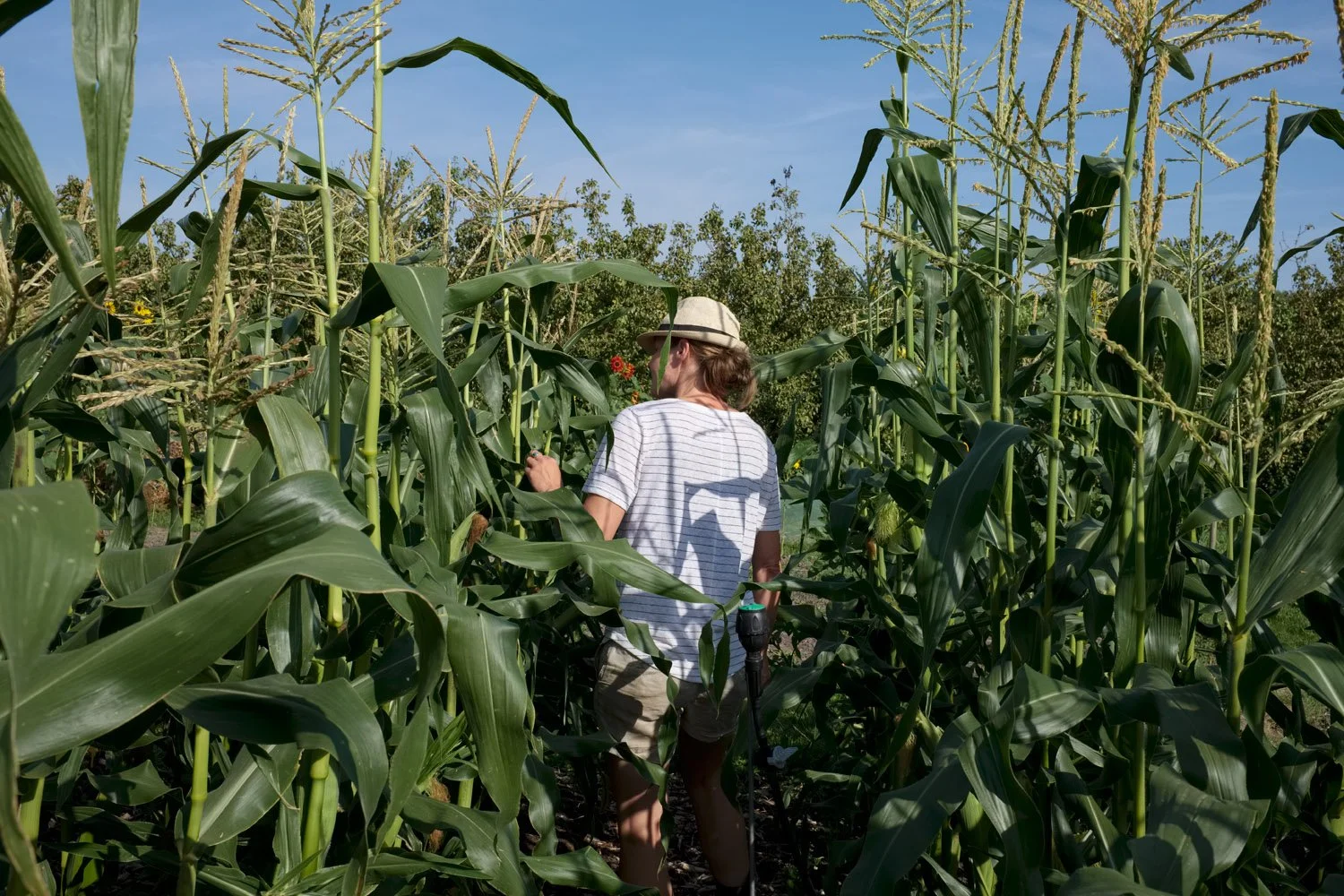
Gardener Jantien checks whether the corn on the cob can already be harvested. August 2024
-
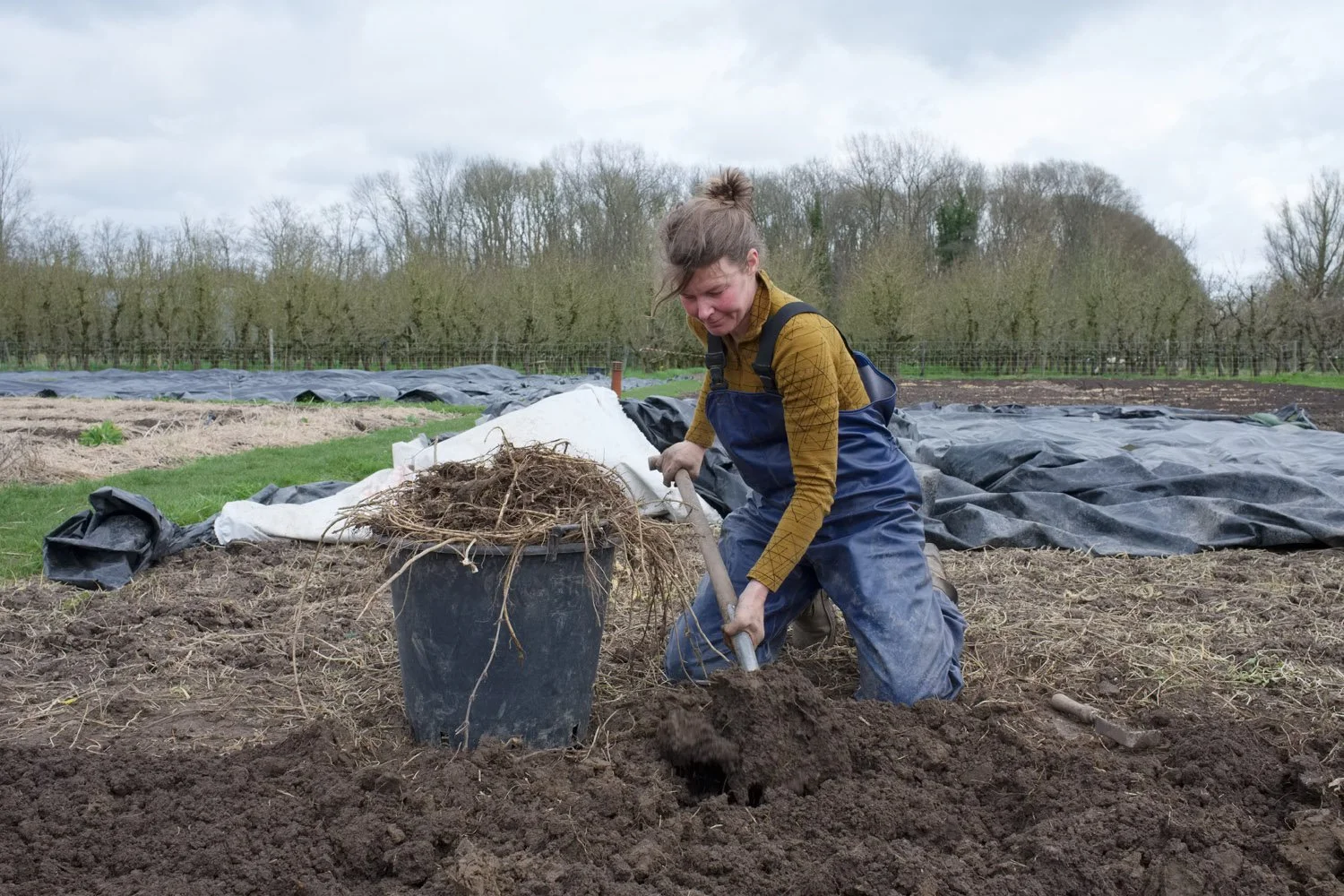
Jantien frees a field from weeds and the roots of couch grass, so that new cultivation beds can be created. It is heavy, precise, slow work. Under the agricultural plastic behind her still lies a whole piece that needs to be cleaned. Couch grass is a plant that uses long underground roots to spread itself. Every inch along the root is a collar of smaller roots. A new plant can grow from any collar. The plant adds organic material to the soil and feeds soil life, which leads to the storage of CO2 in the ground. It is also a host plant for certain butterfly species, but because it has a competitive advantage, you don't want it in your vegetable beds. At the Proeftuin they remove the usury plant by hand, work that takes hours of patient clearing, piece of land after piece of land. March 2024
-
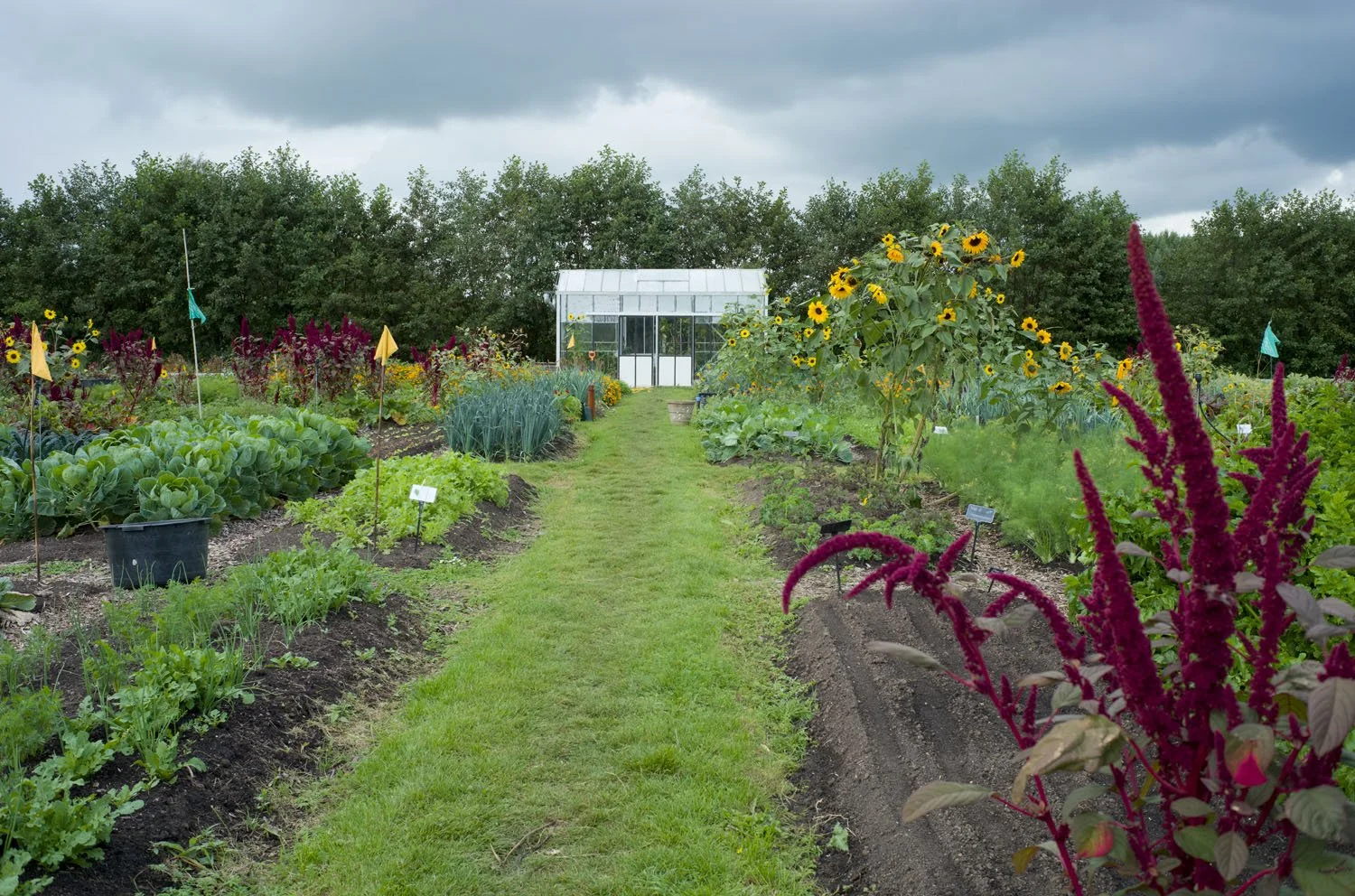
The Proeftuin van Linschoten in late summer, while a rain shower is approaching. August 2024
Photos and text © Ellen Kok, www.netherlight.org.
A Place for a Chat or a Tasty Carrot is the third and final story of my photo project Farming for the Neighbors about two farms in the United States and a market garden in the Netherlands that sell local customers healthy, fresh produce through a subscription and involve them in its cultivation. Their sales model follows the principle of Community Supported Agriculture (CSA), and they use nature-friendly growing methods.
For more information visit the project page on my website.
You can read the other two stories here: Build Soil and By Horse and by Hand.
